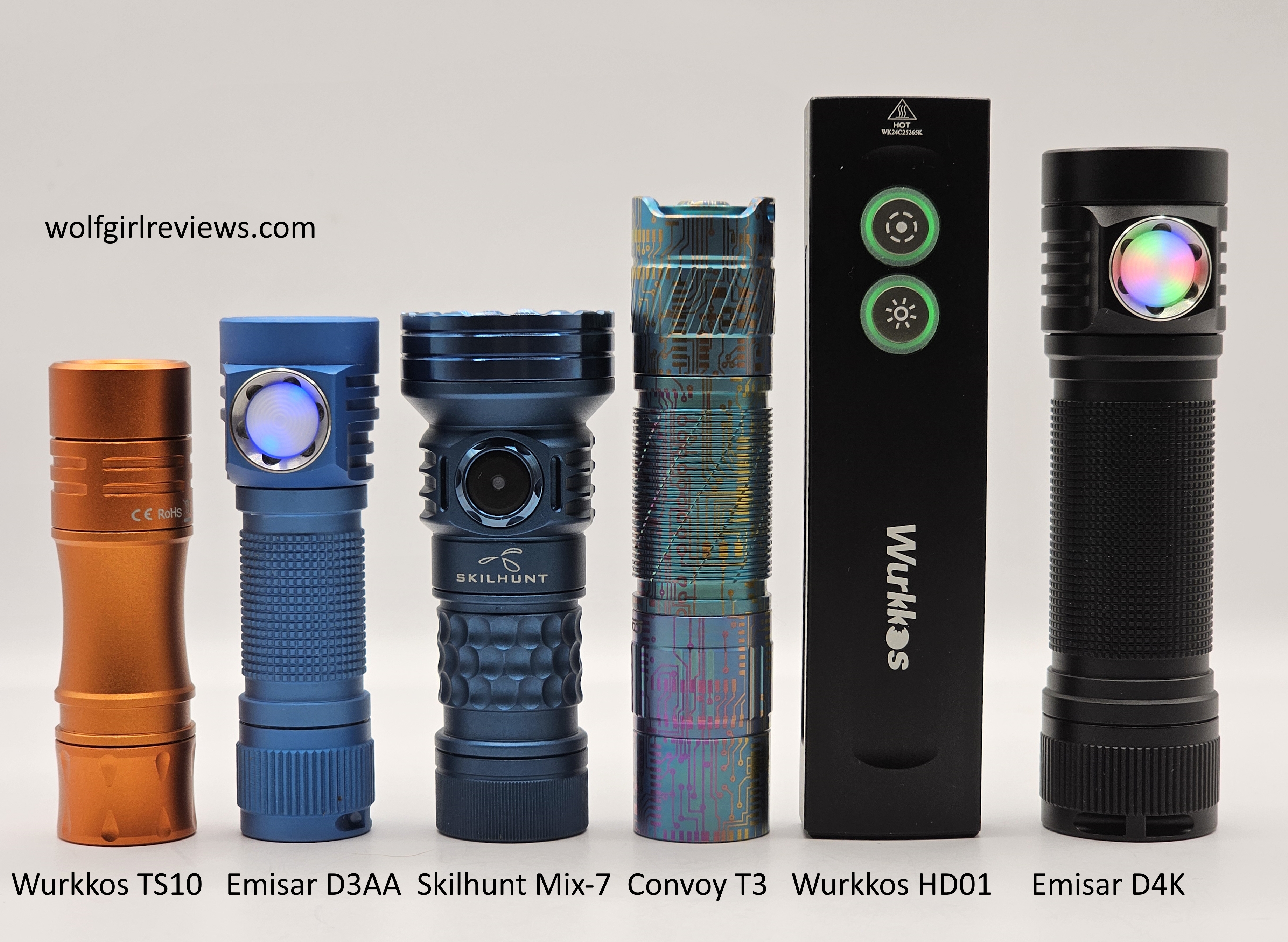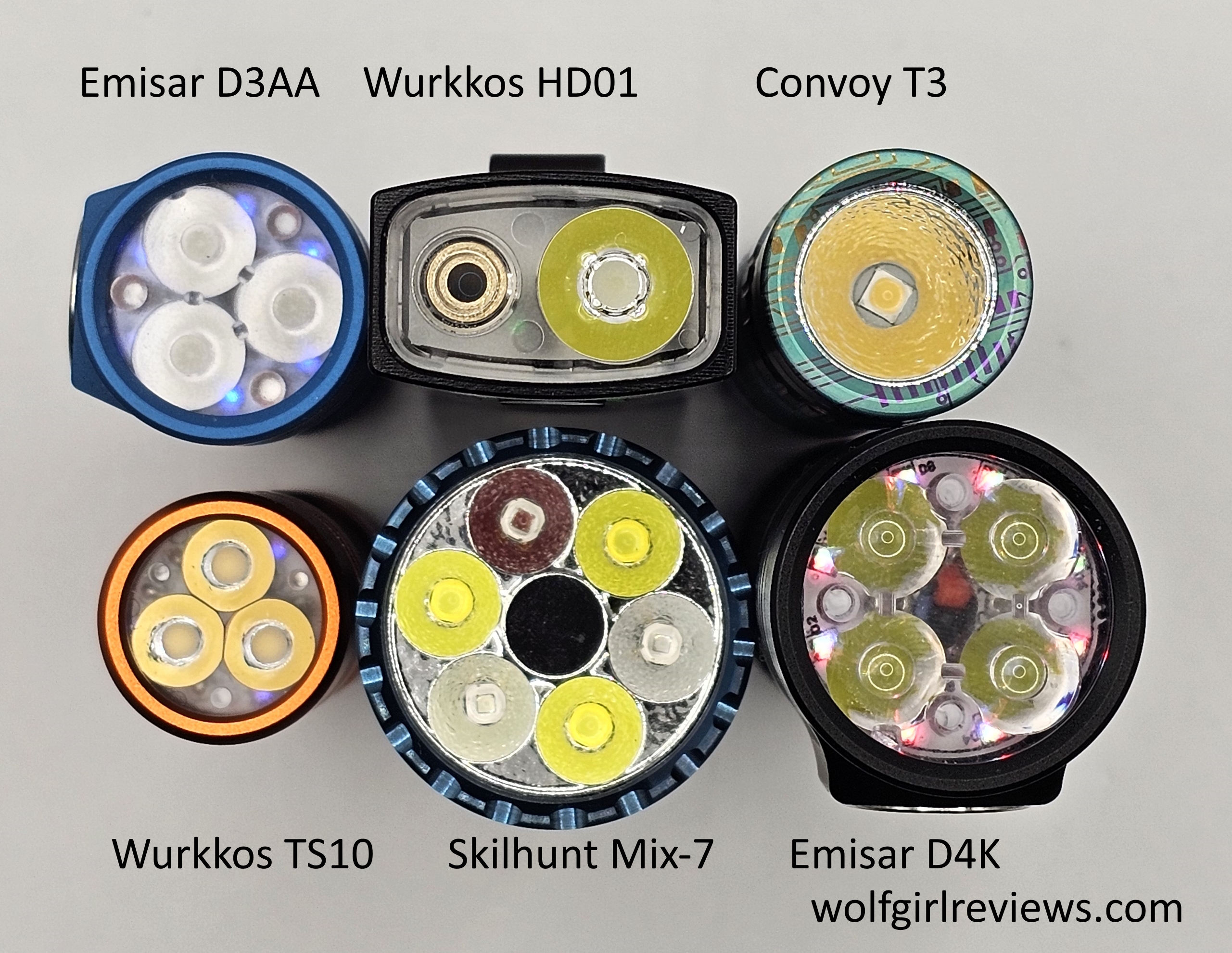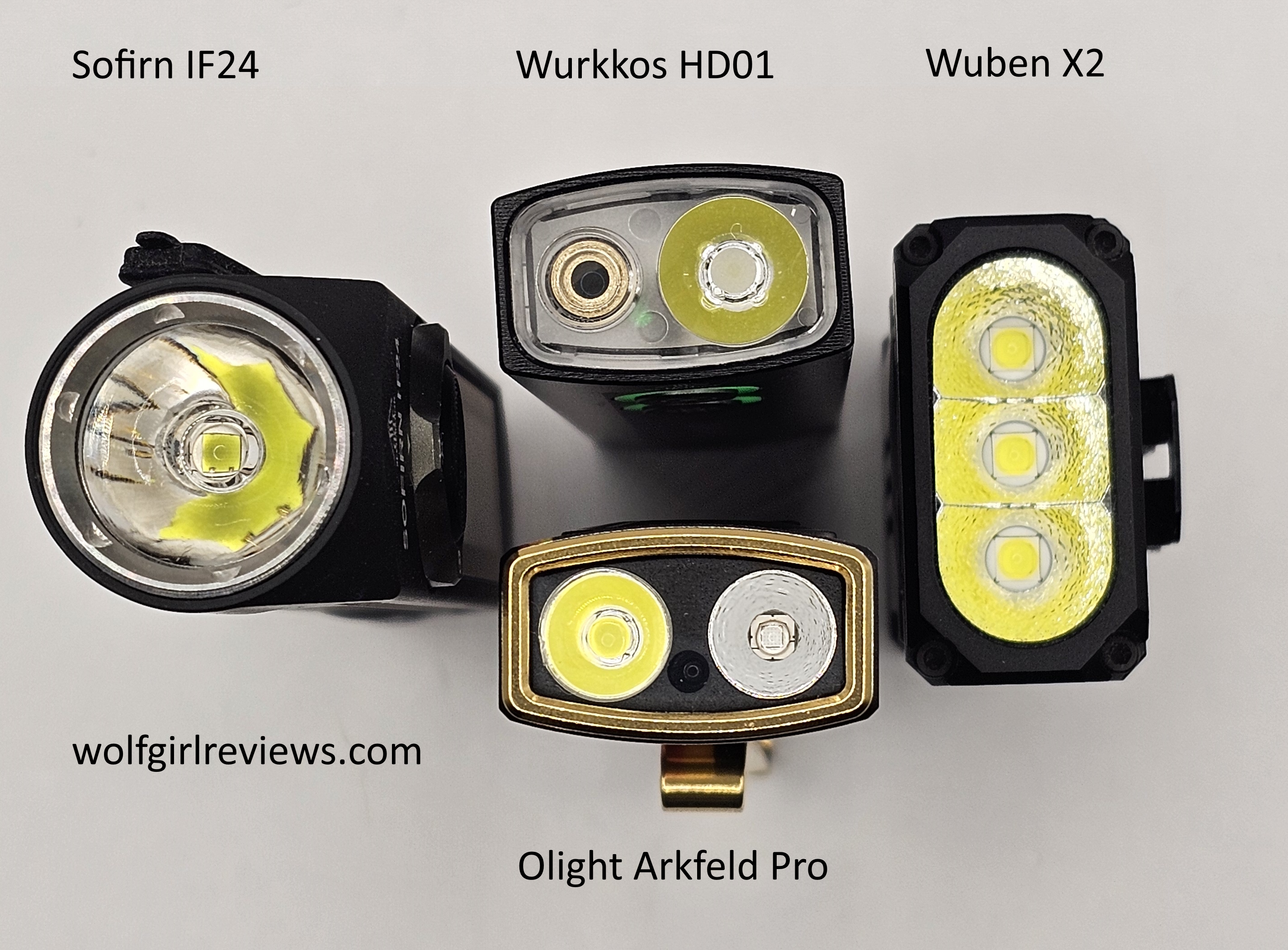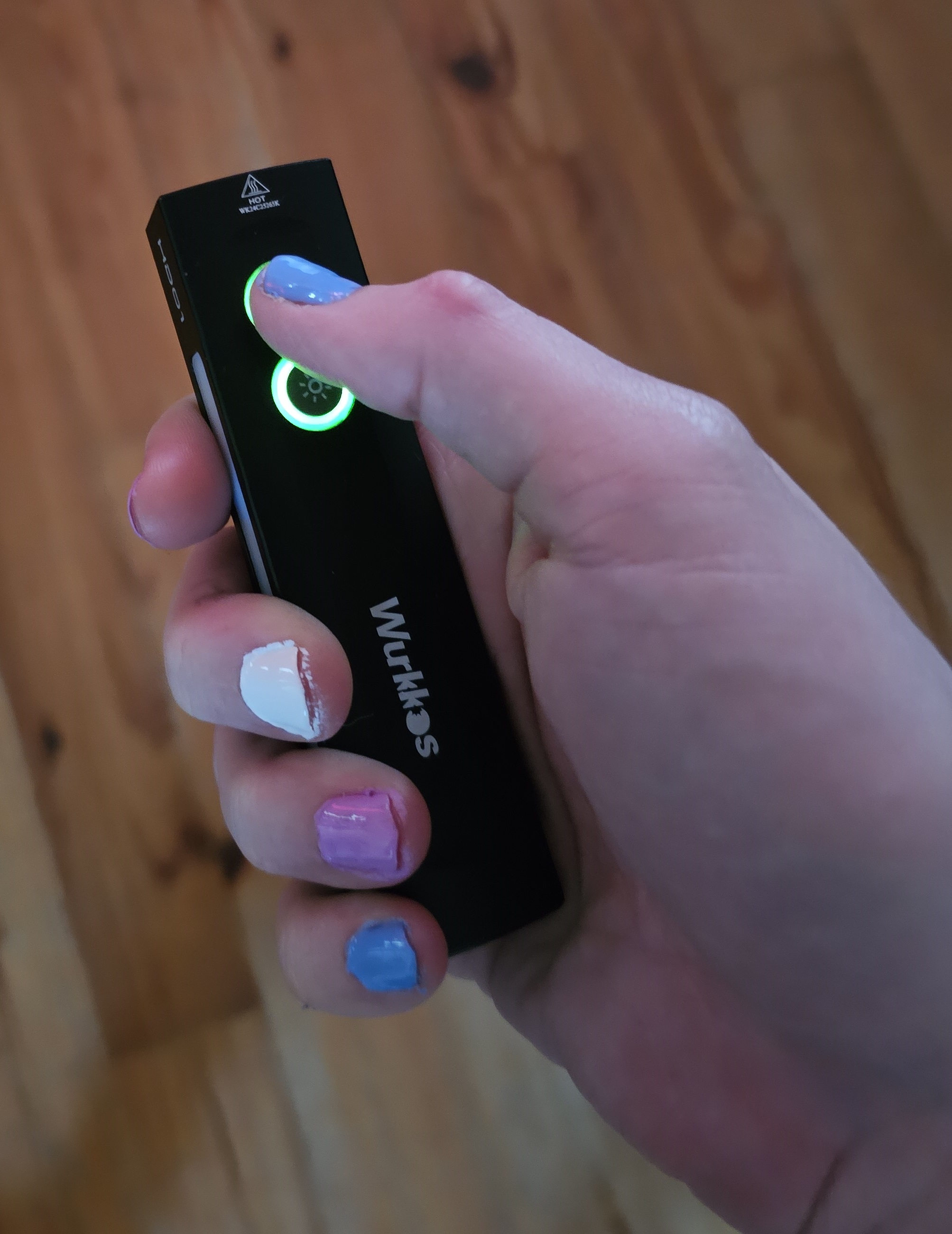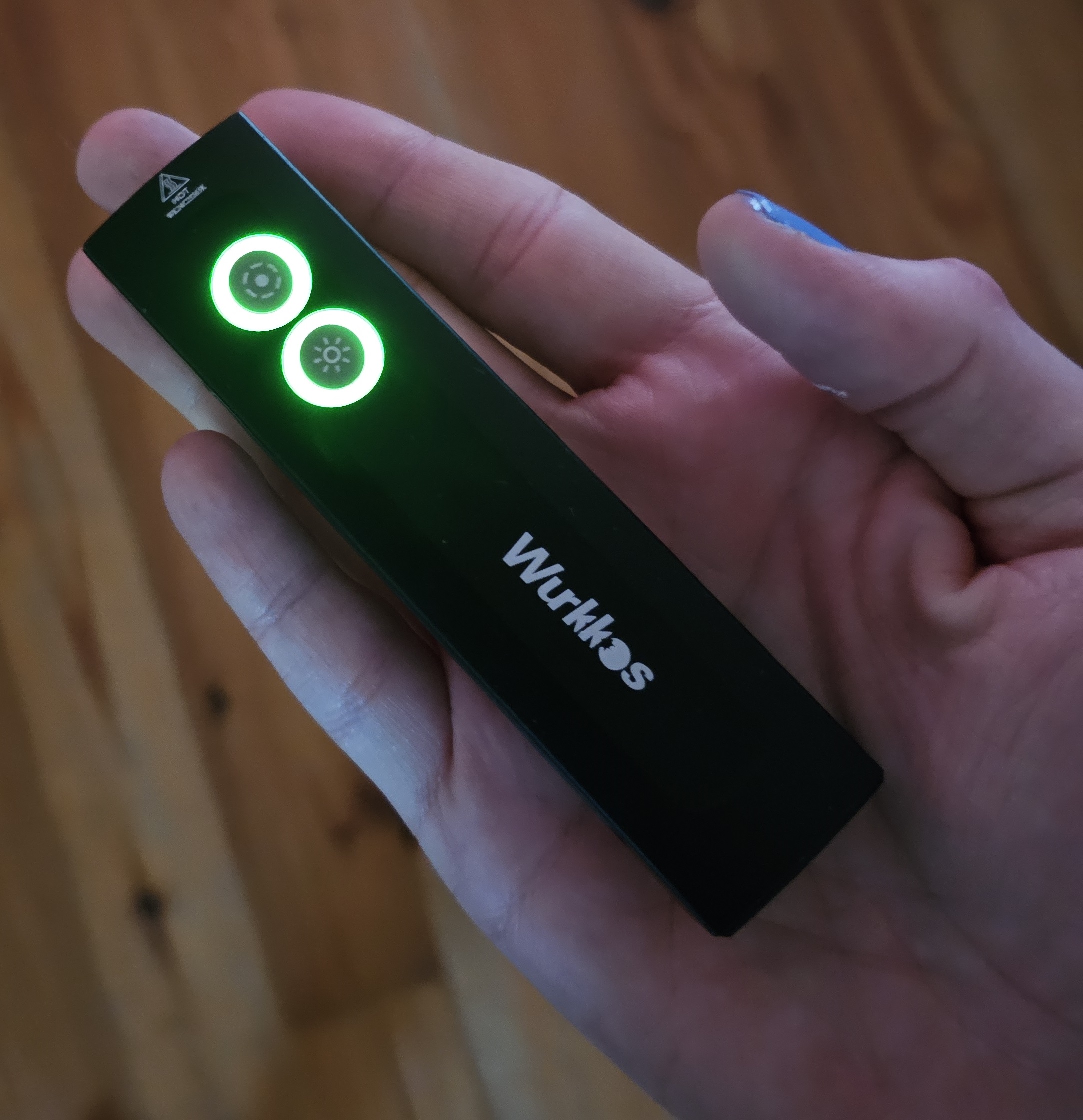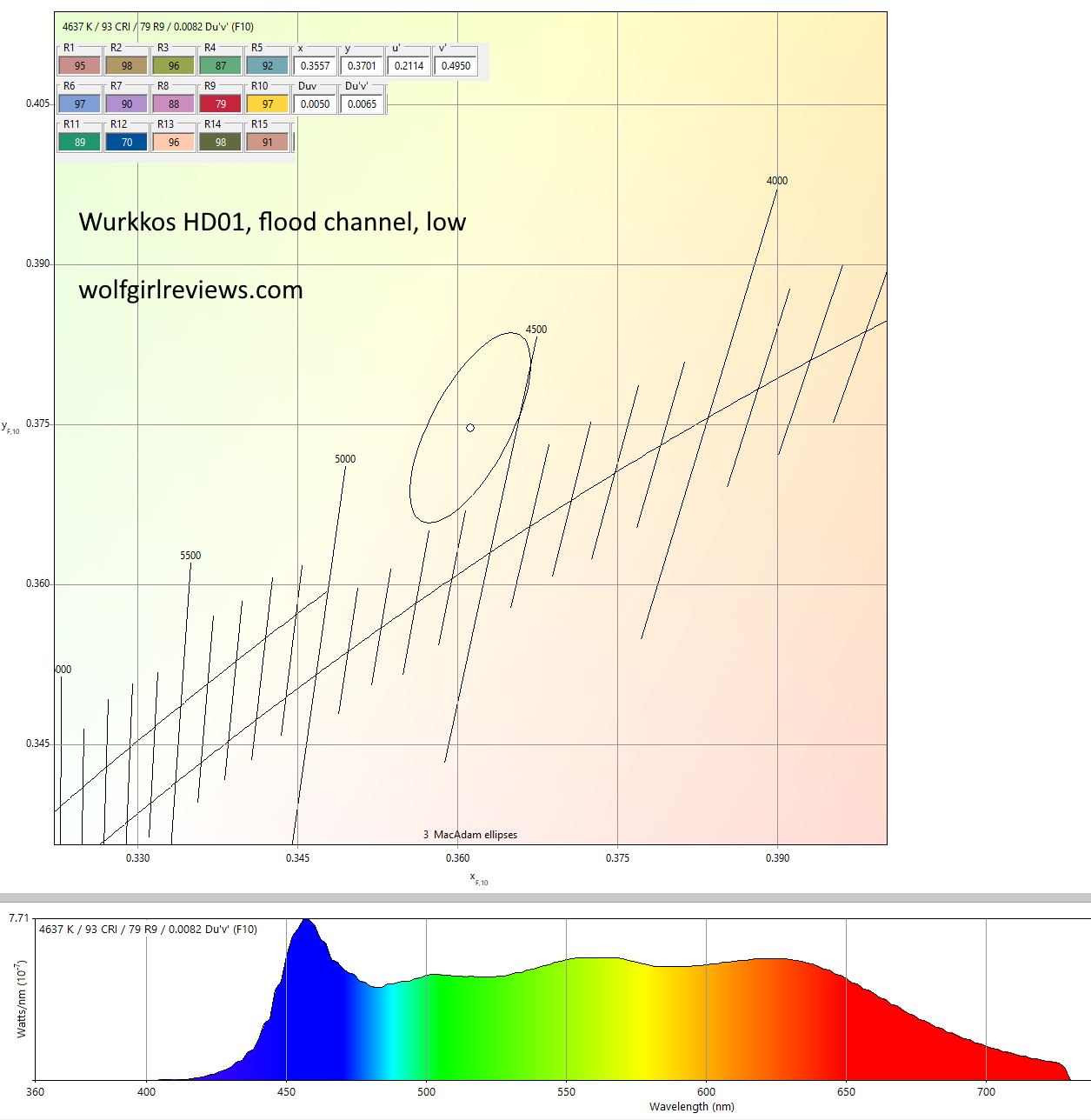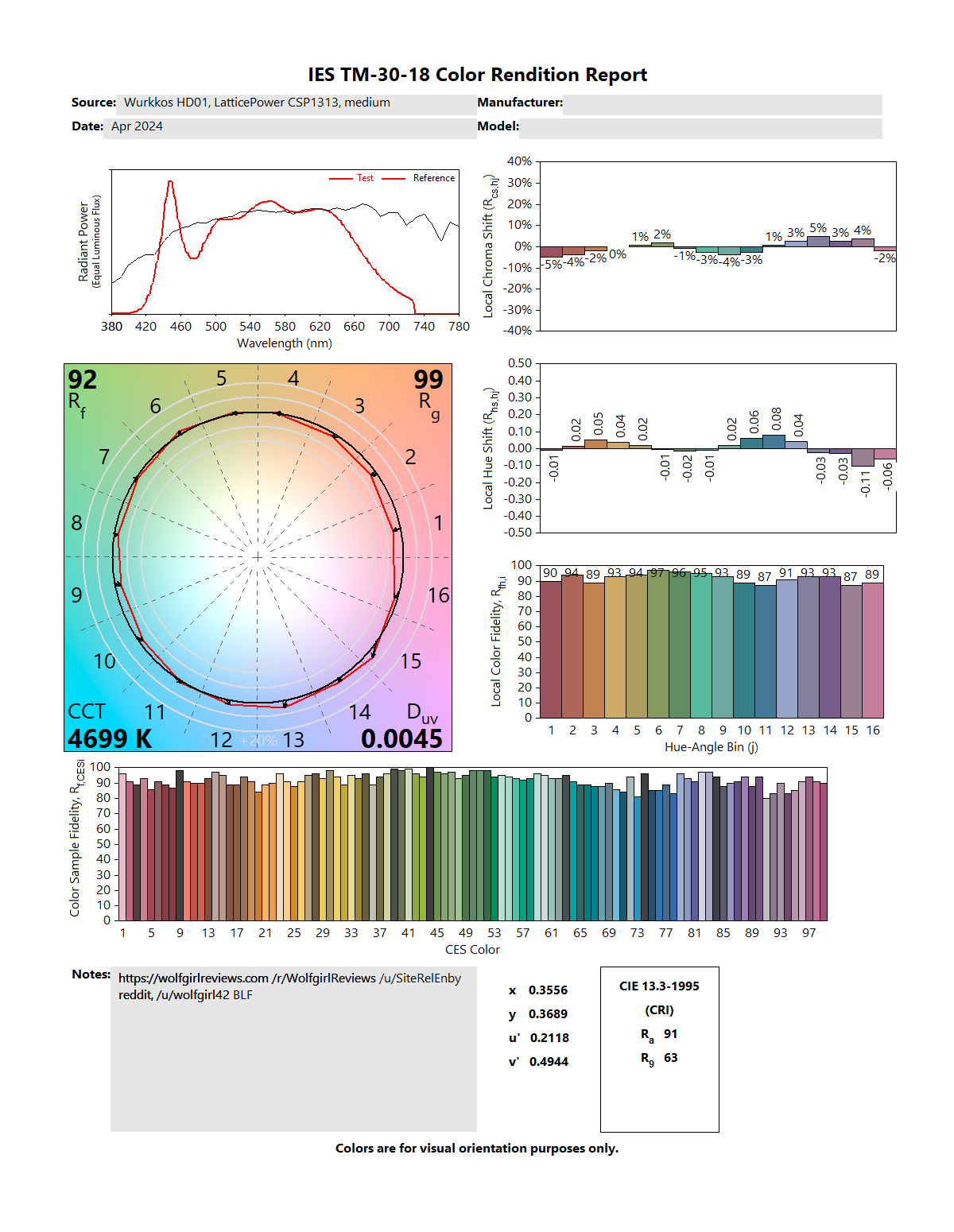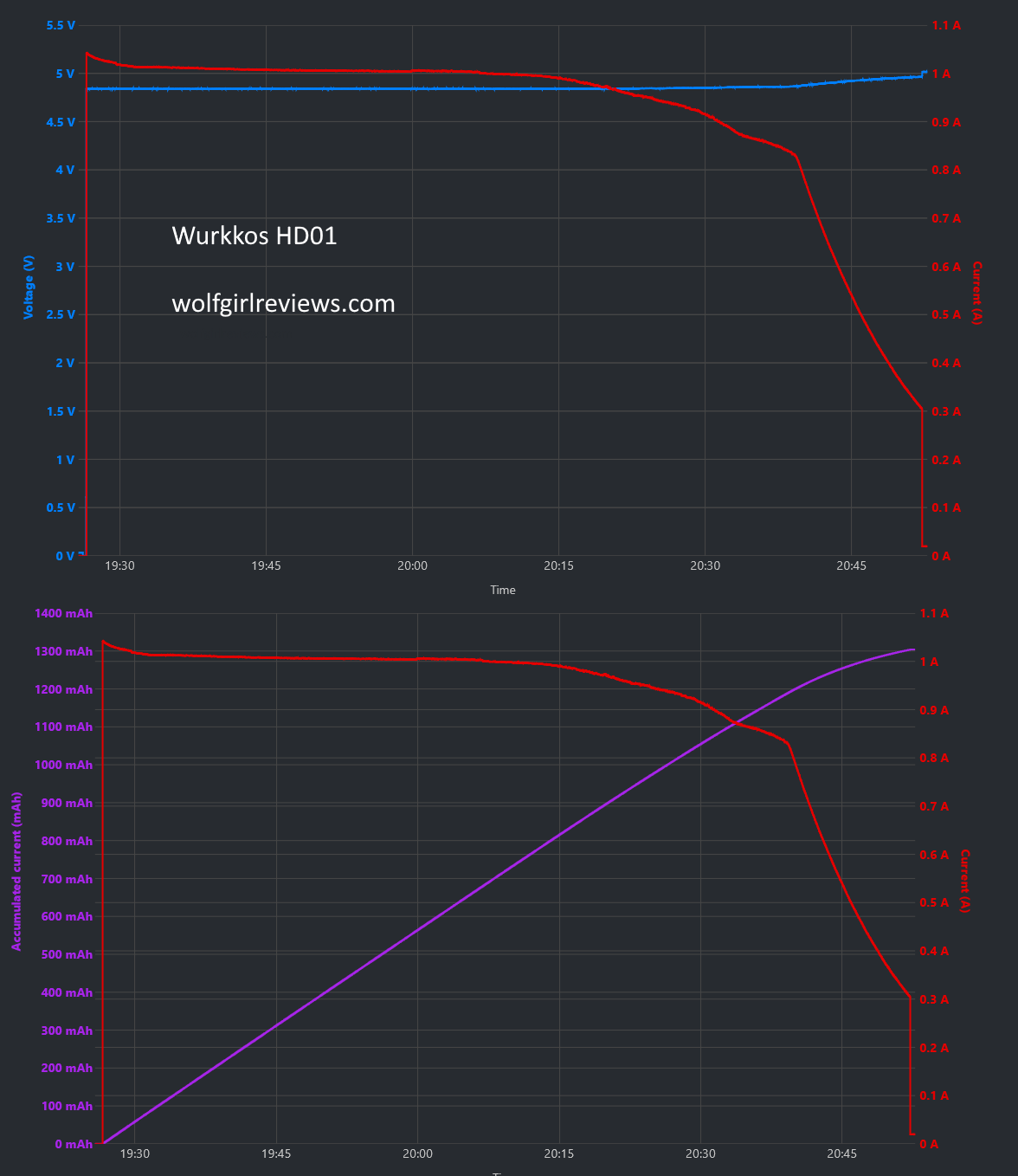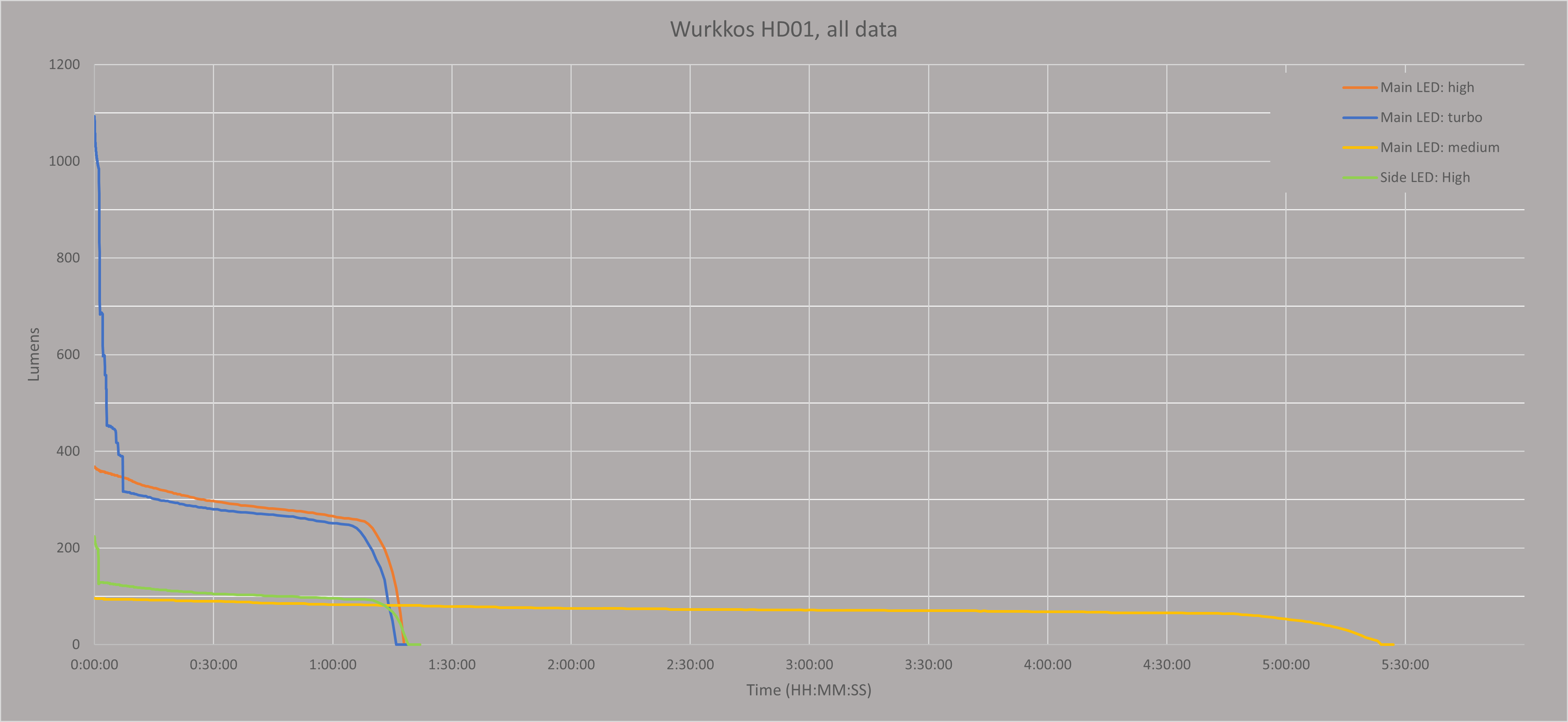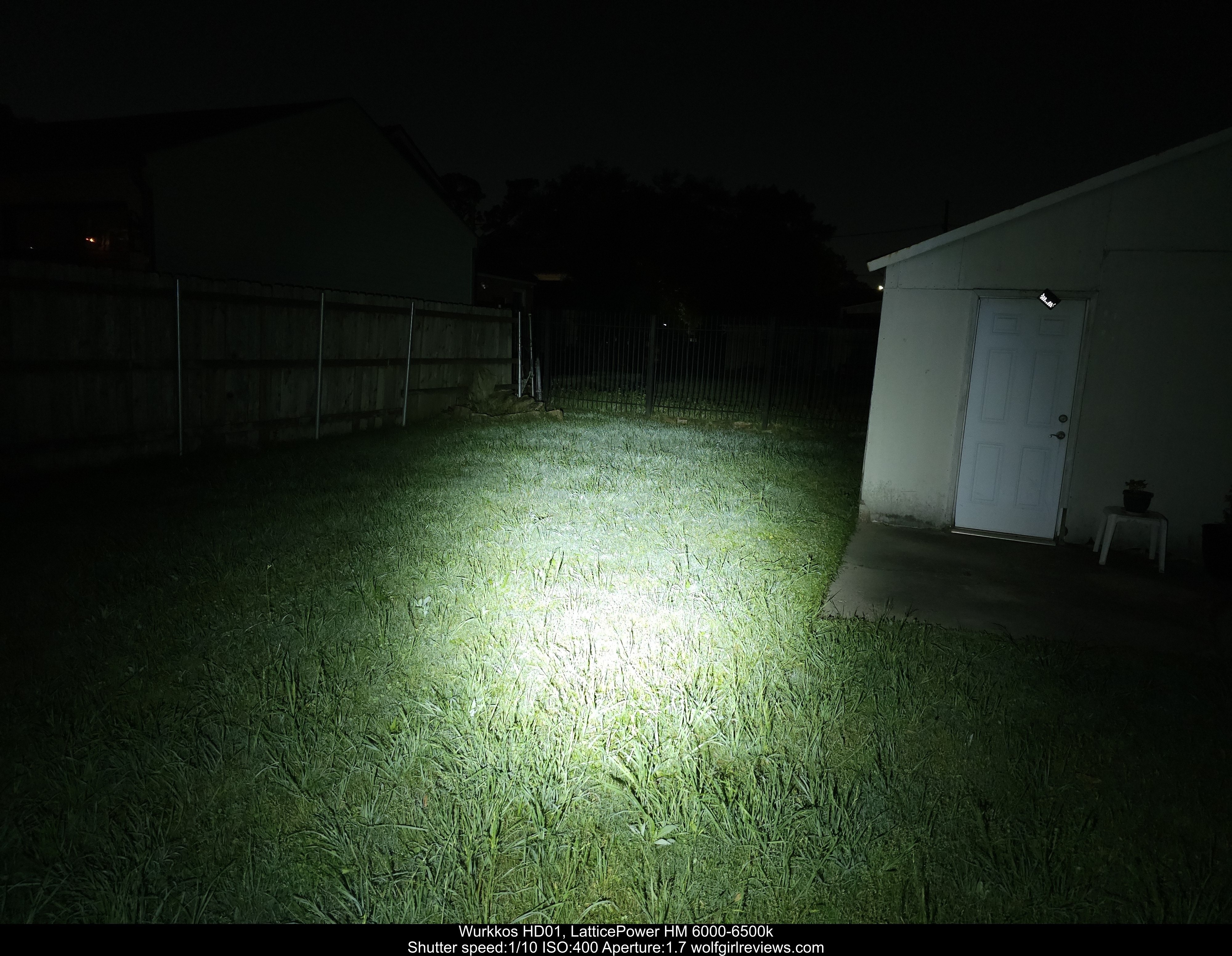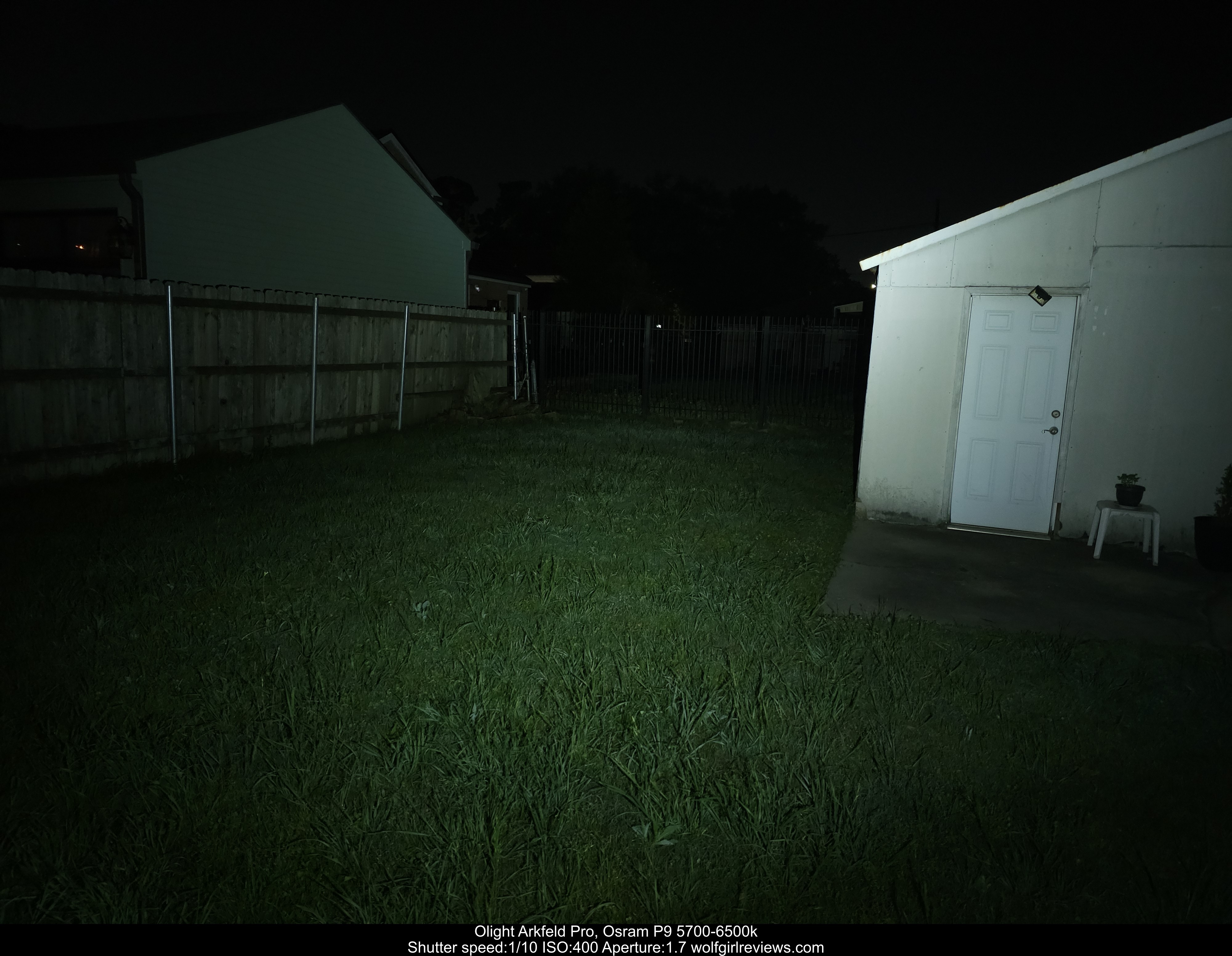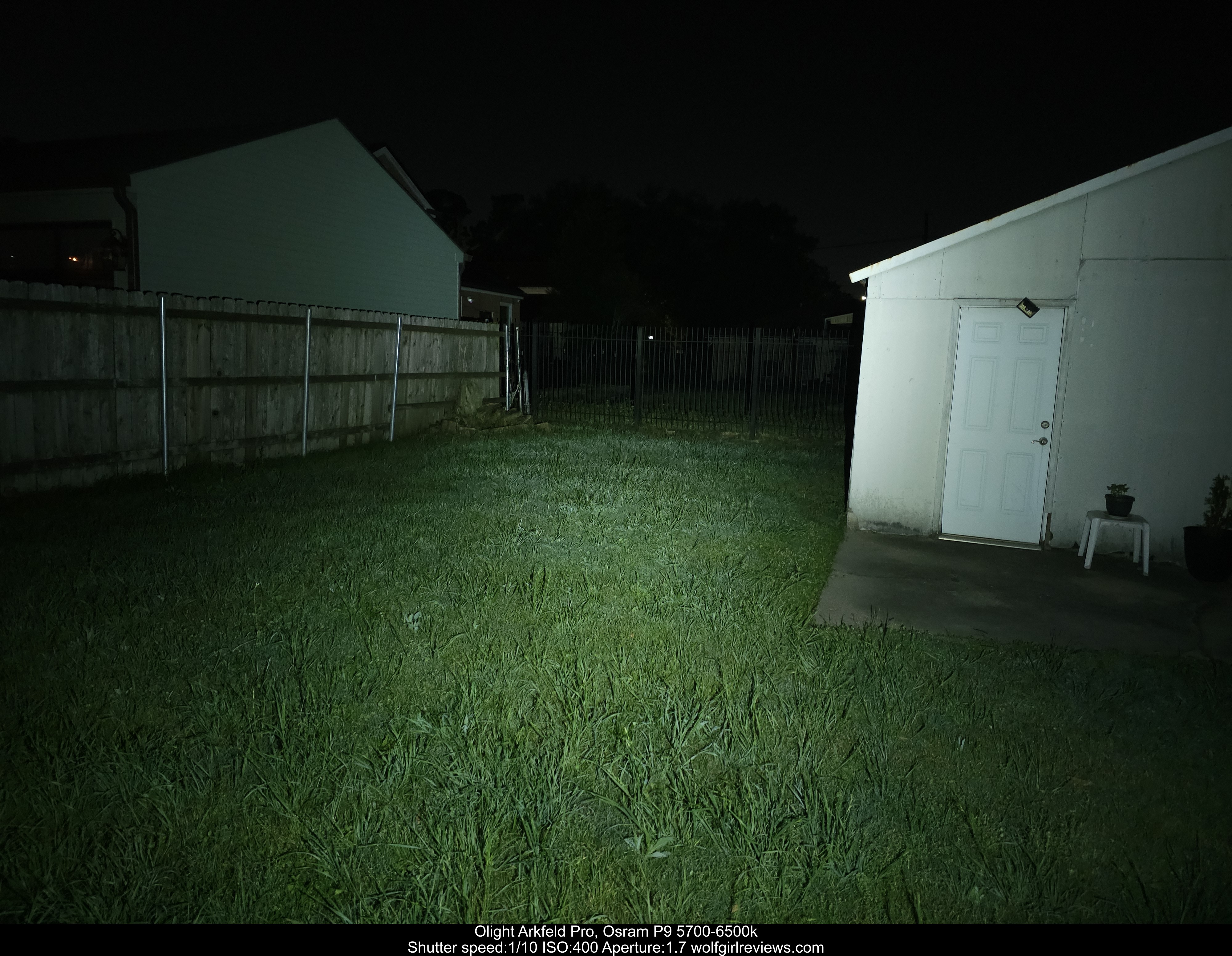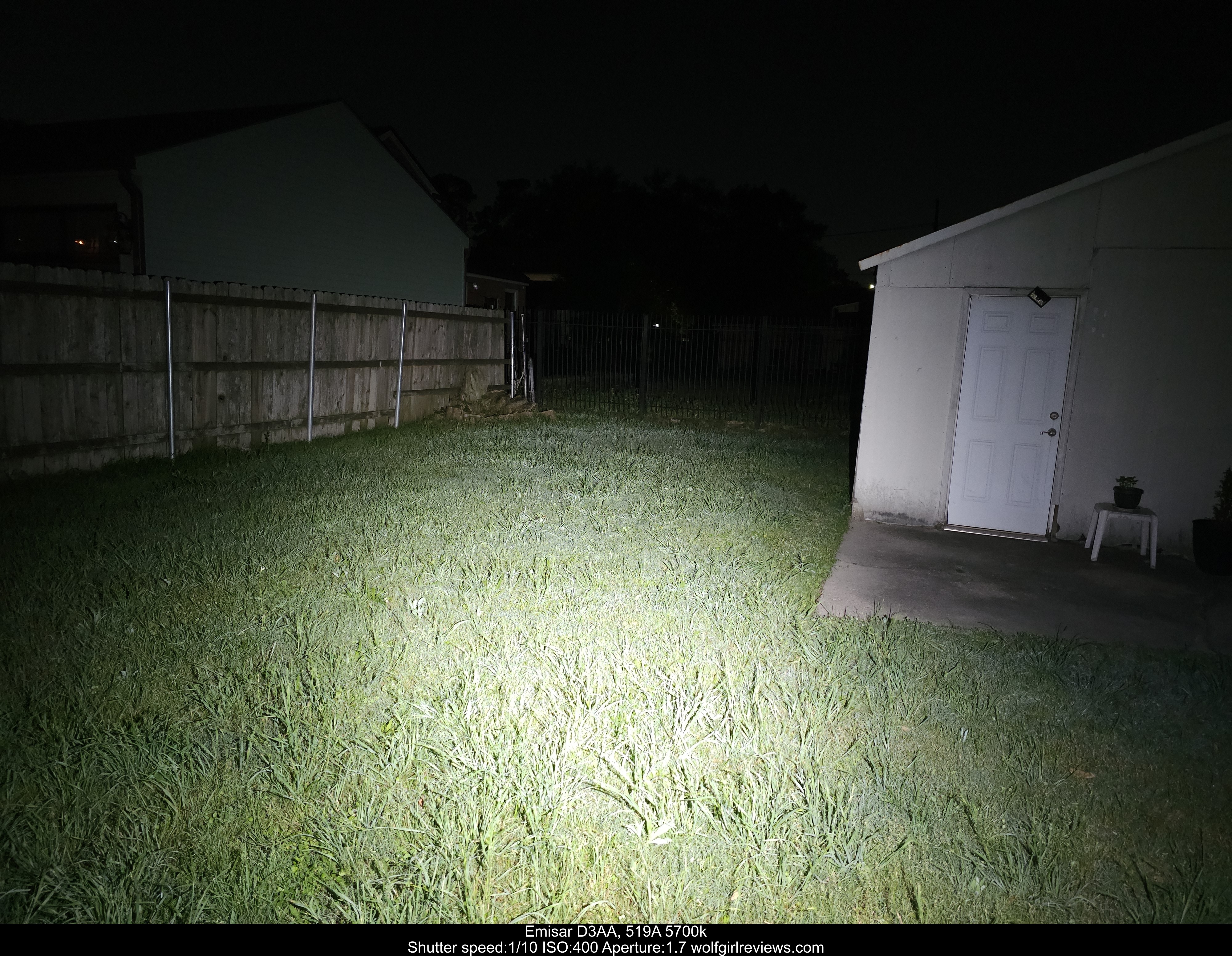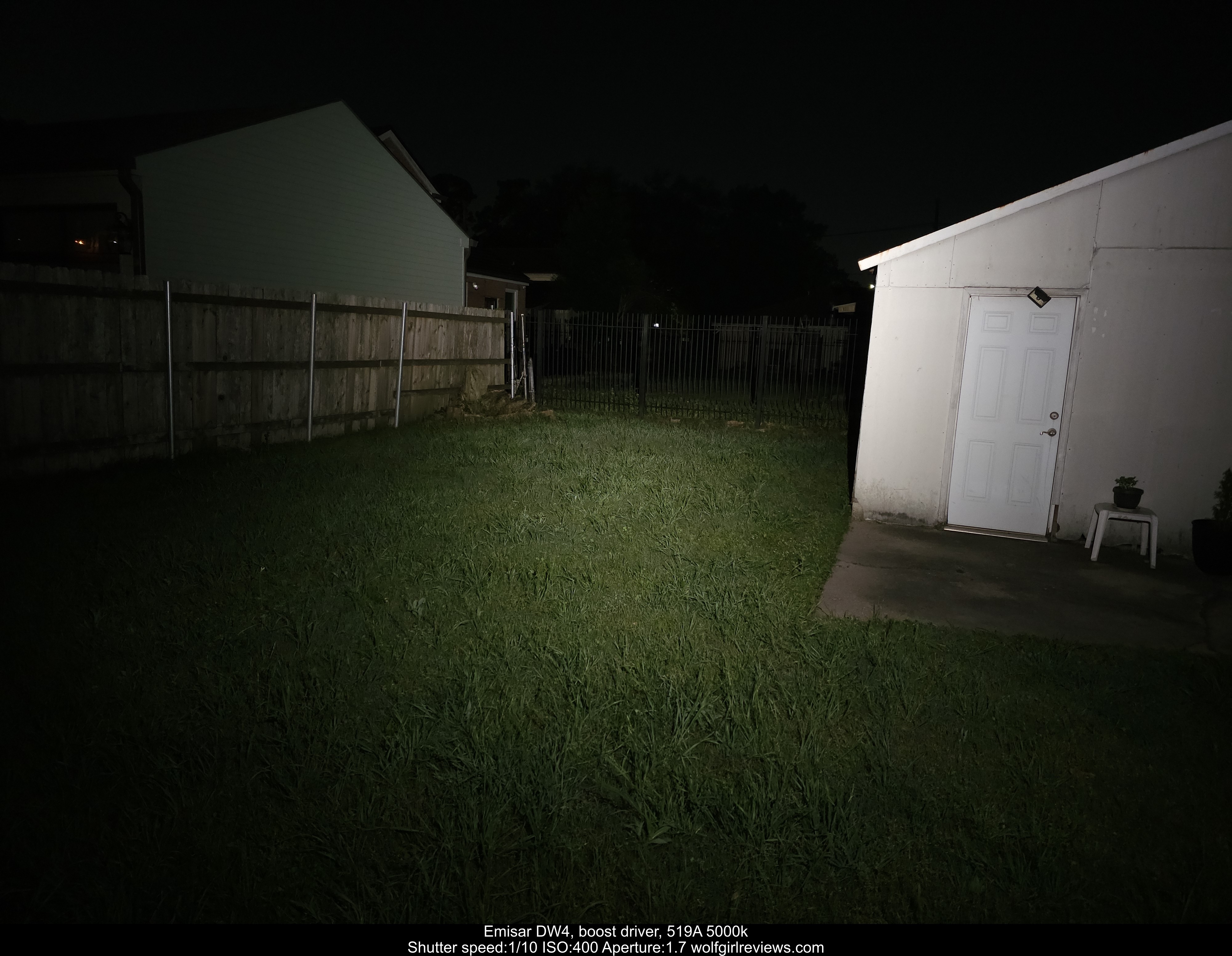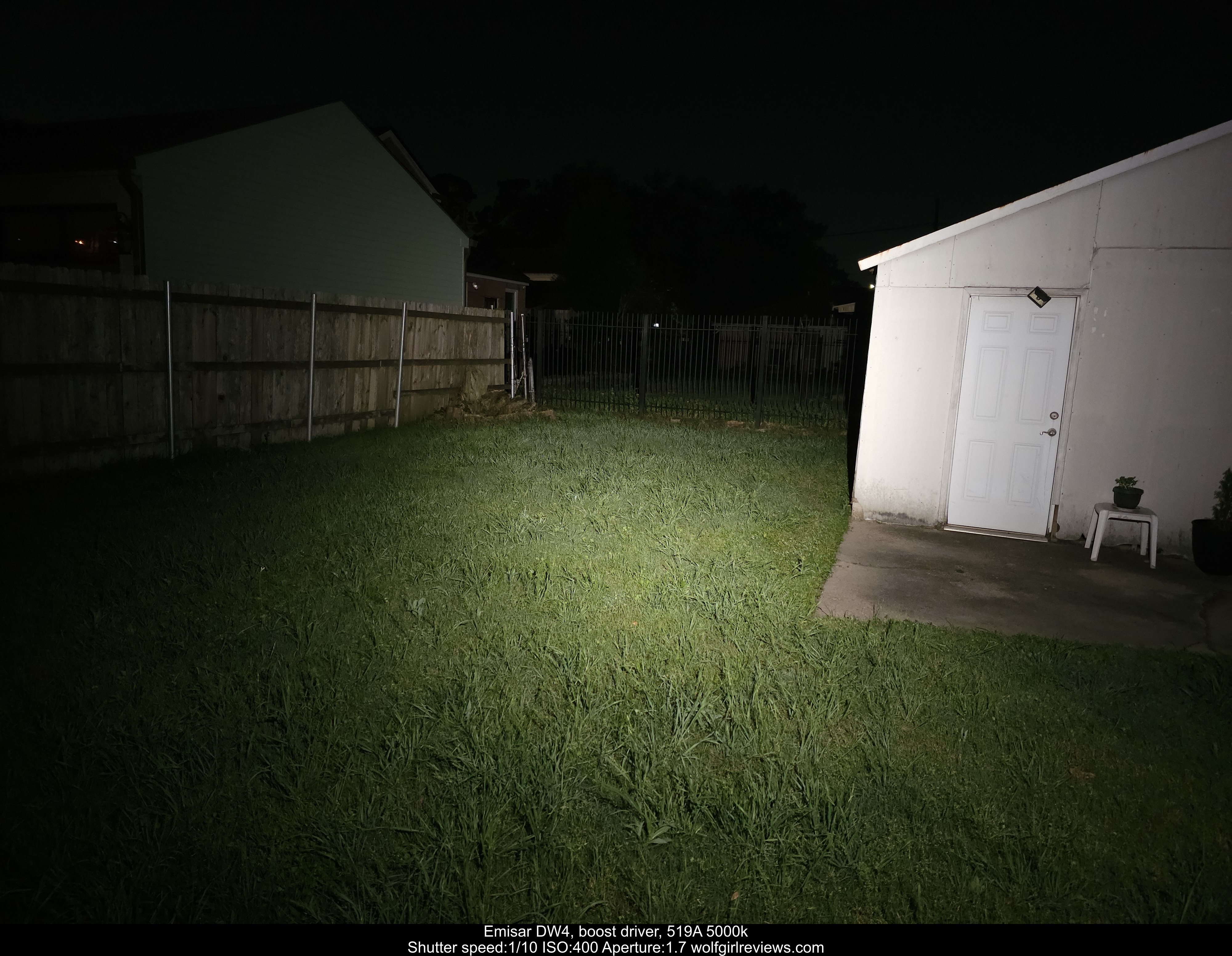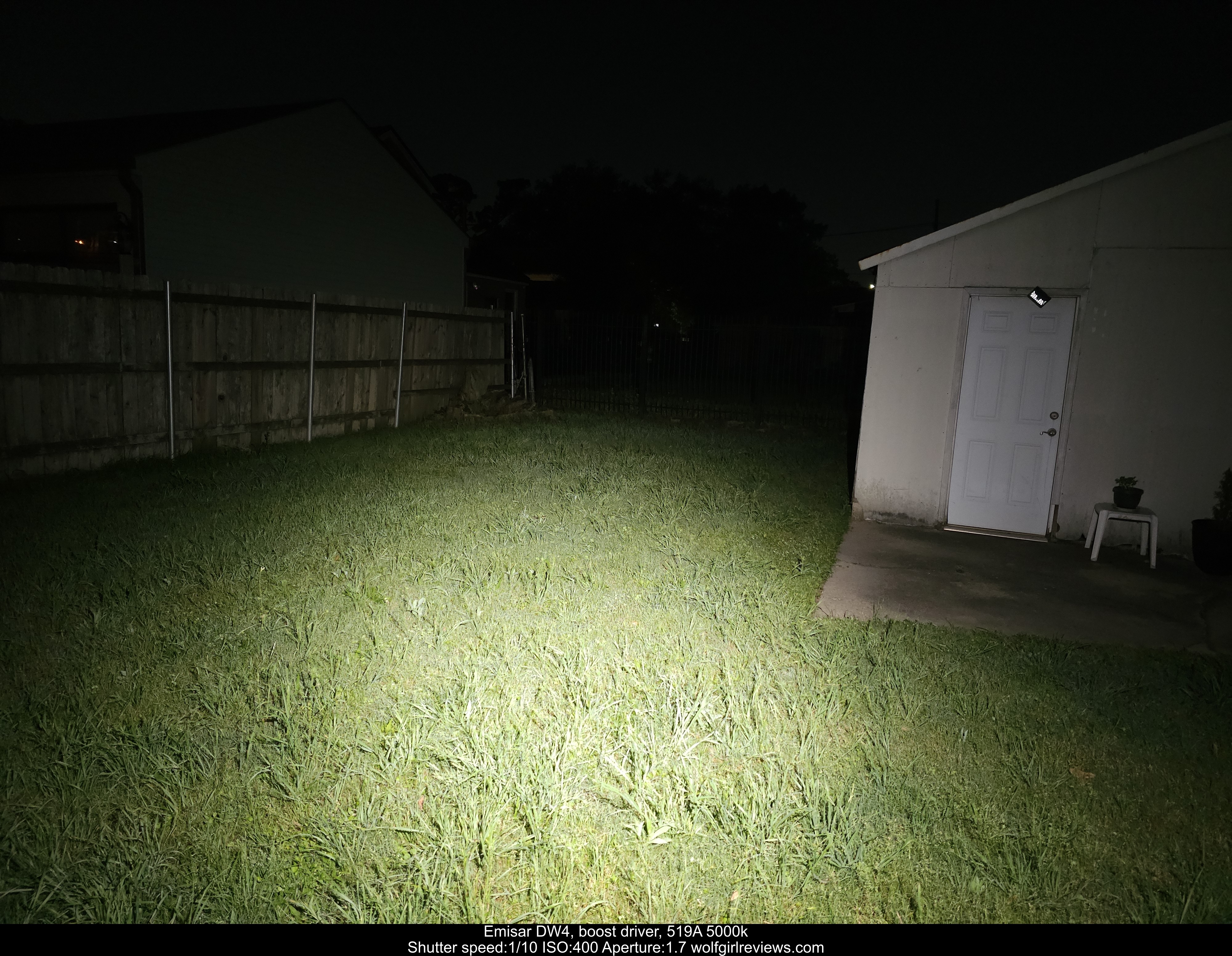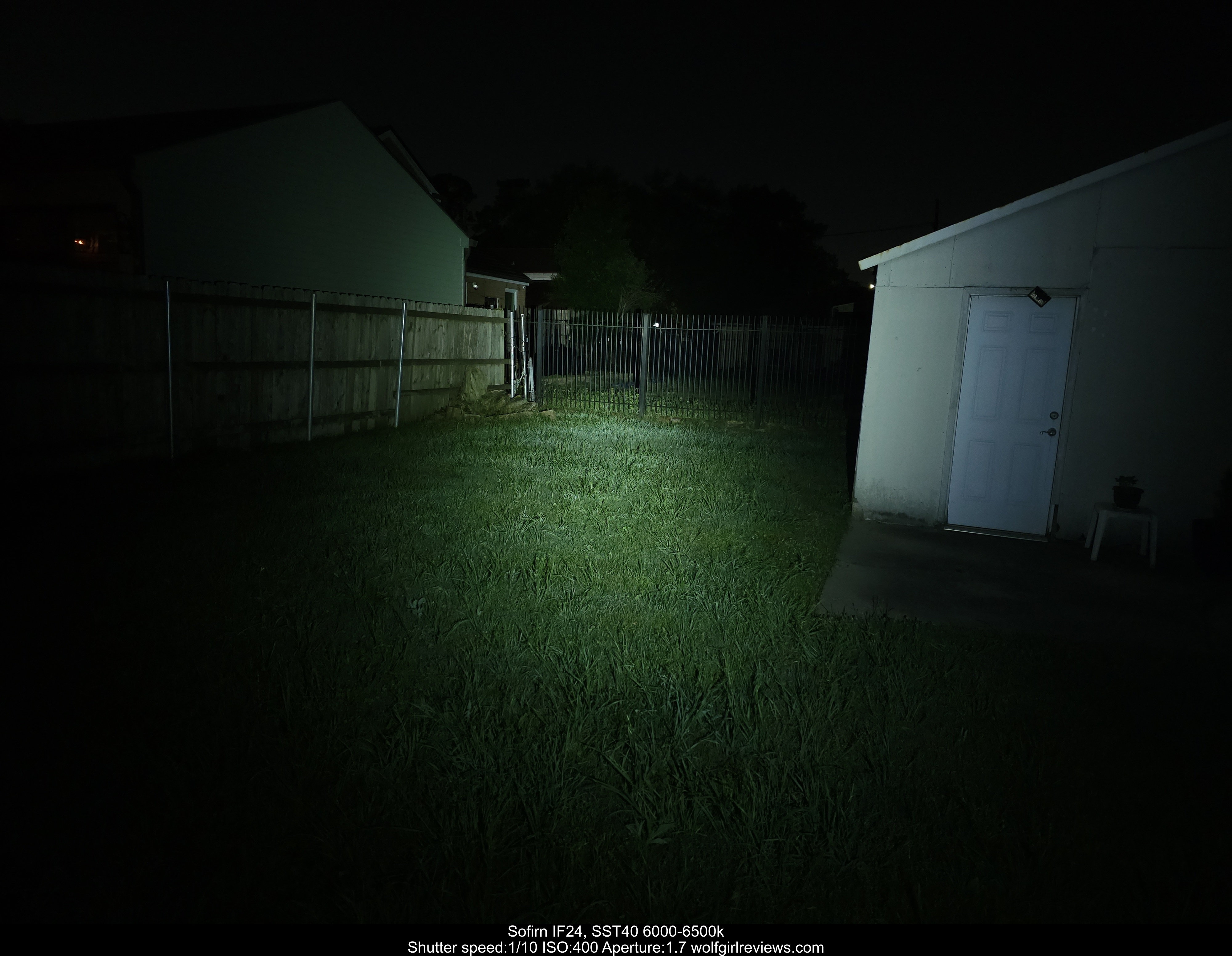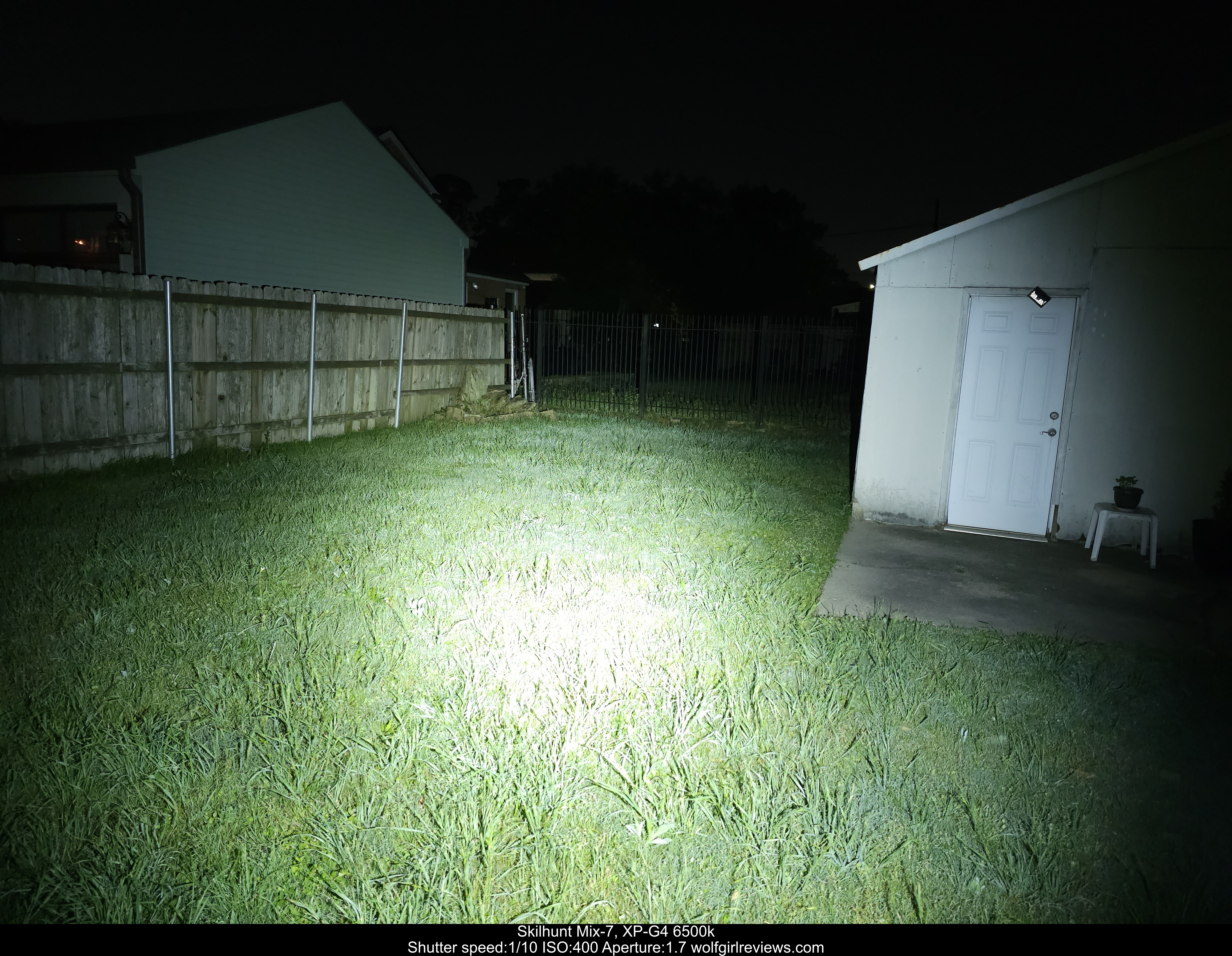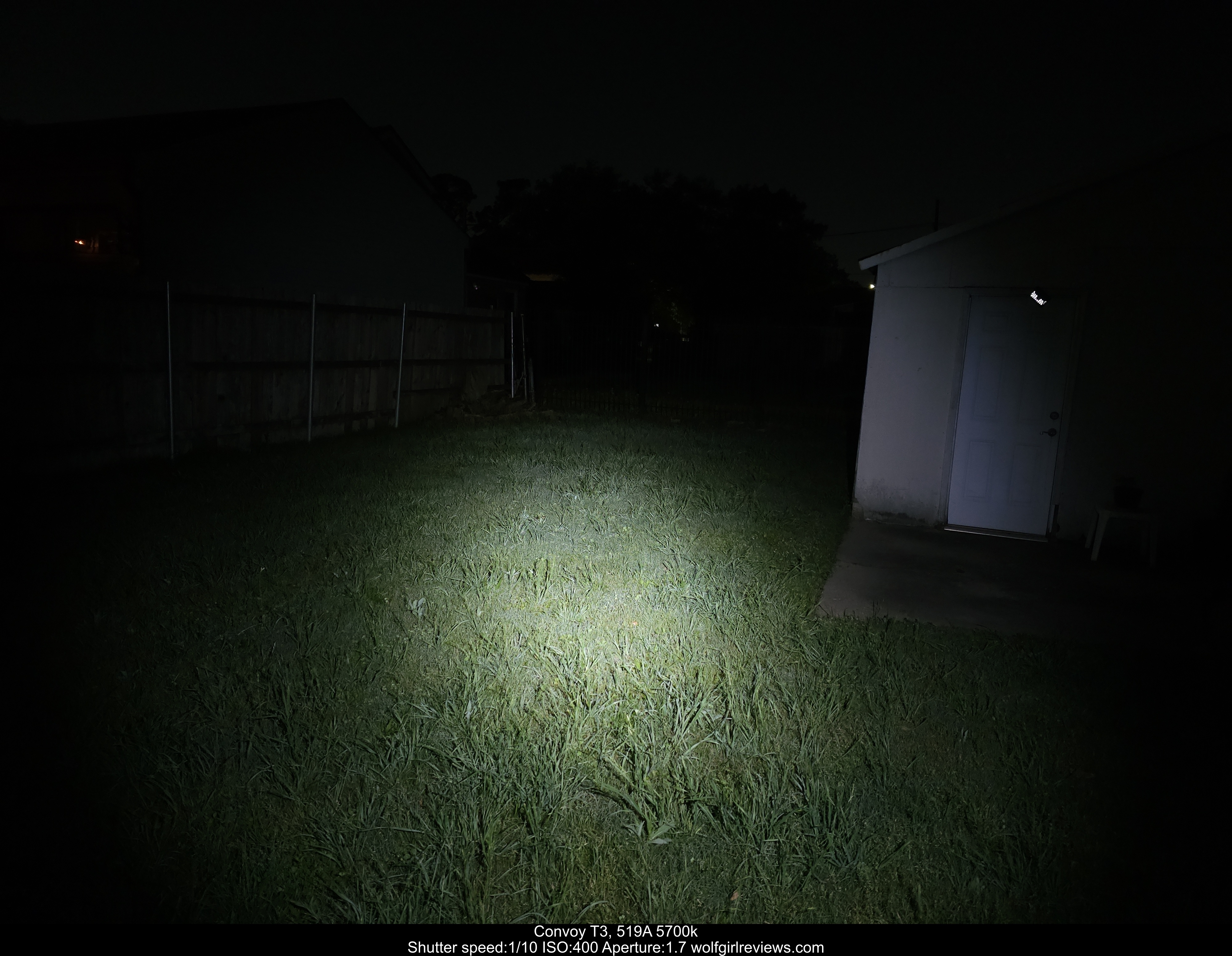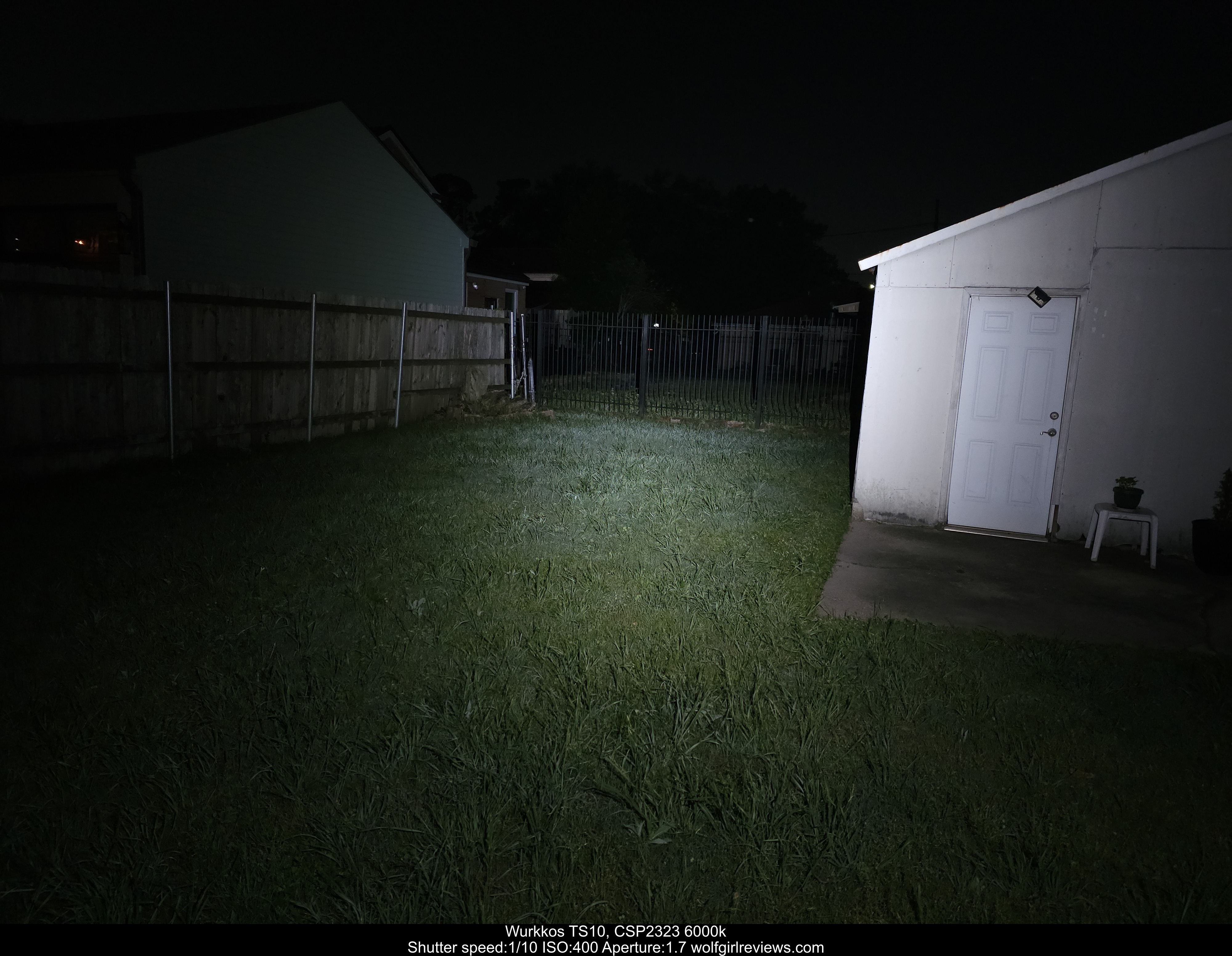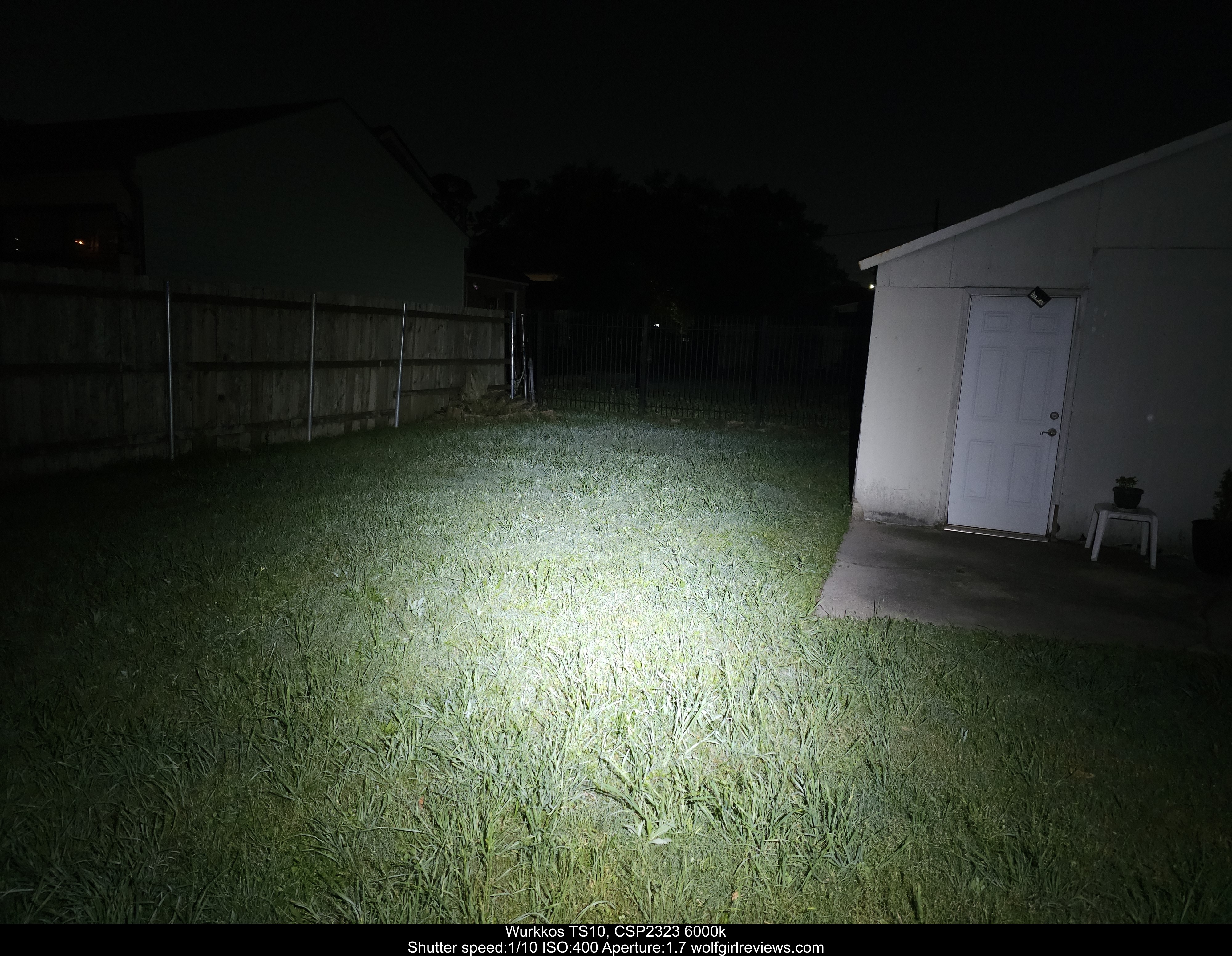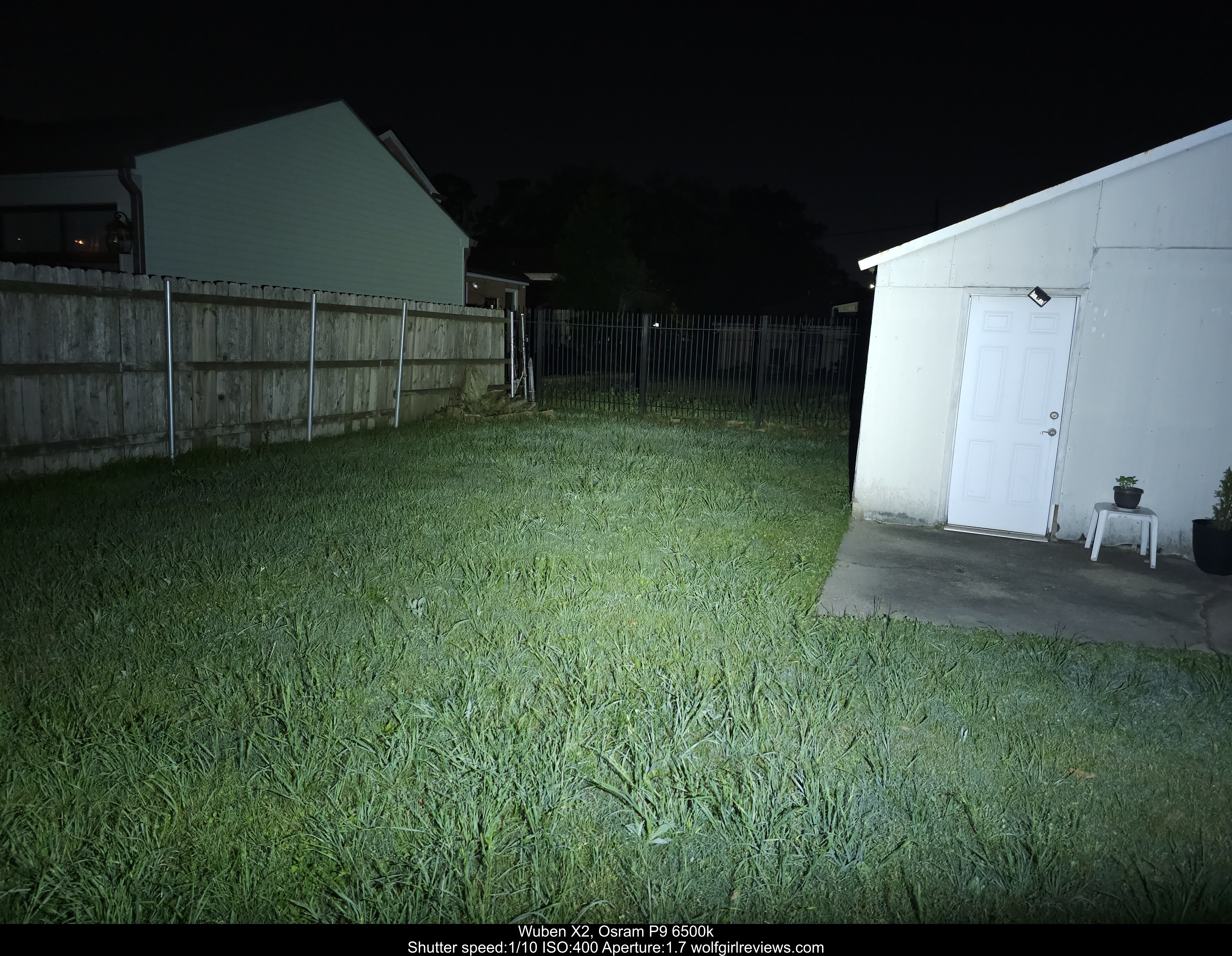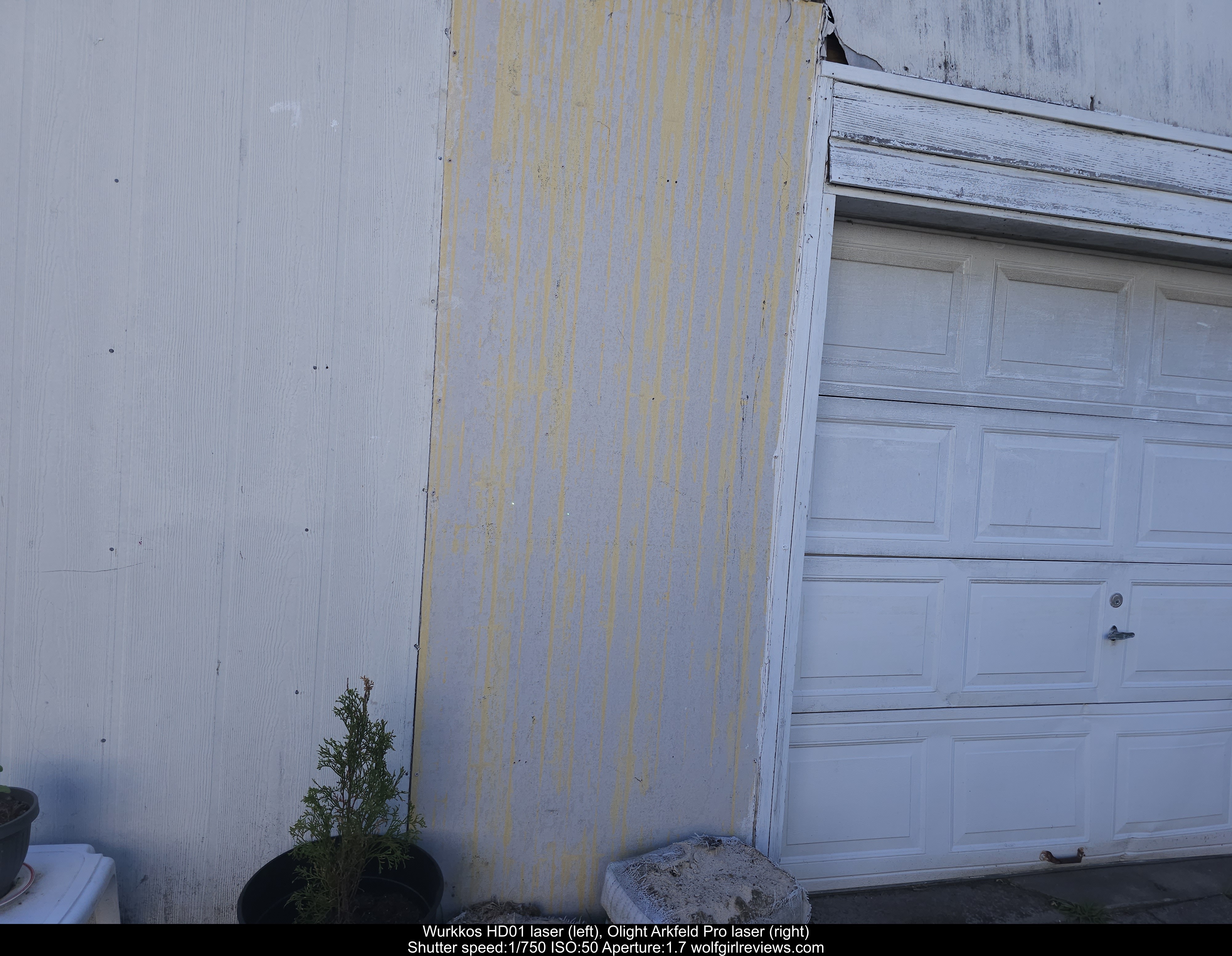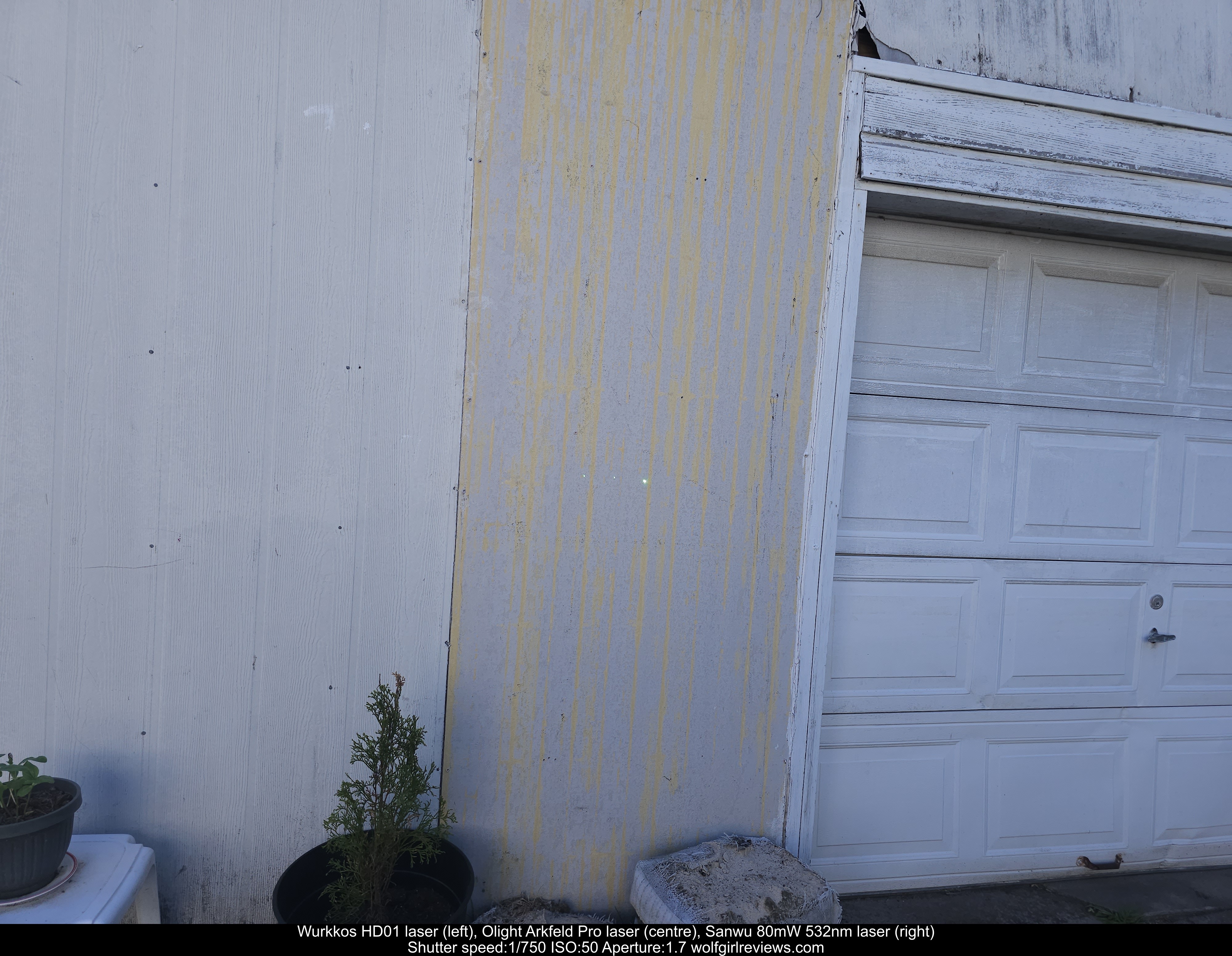"The Wurkkos HD01, with precision aimable strobe mode!"
"Arkfeld killer? Maybe."
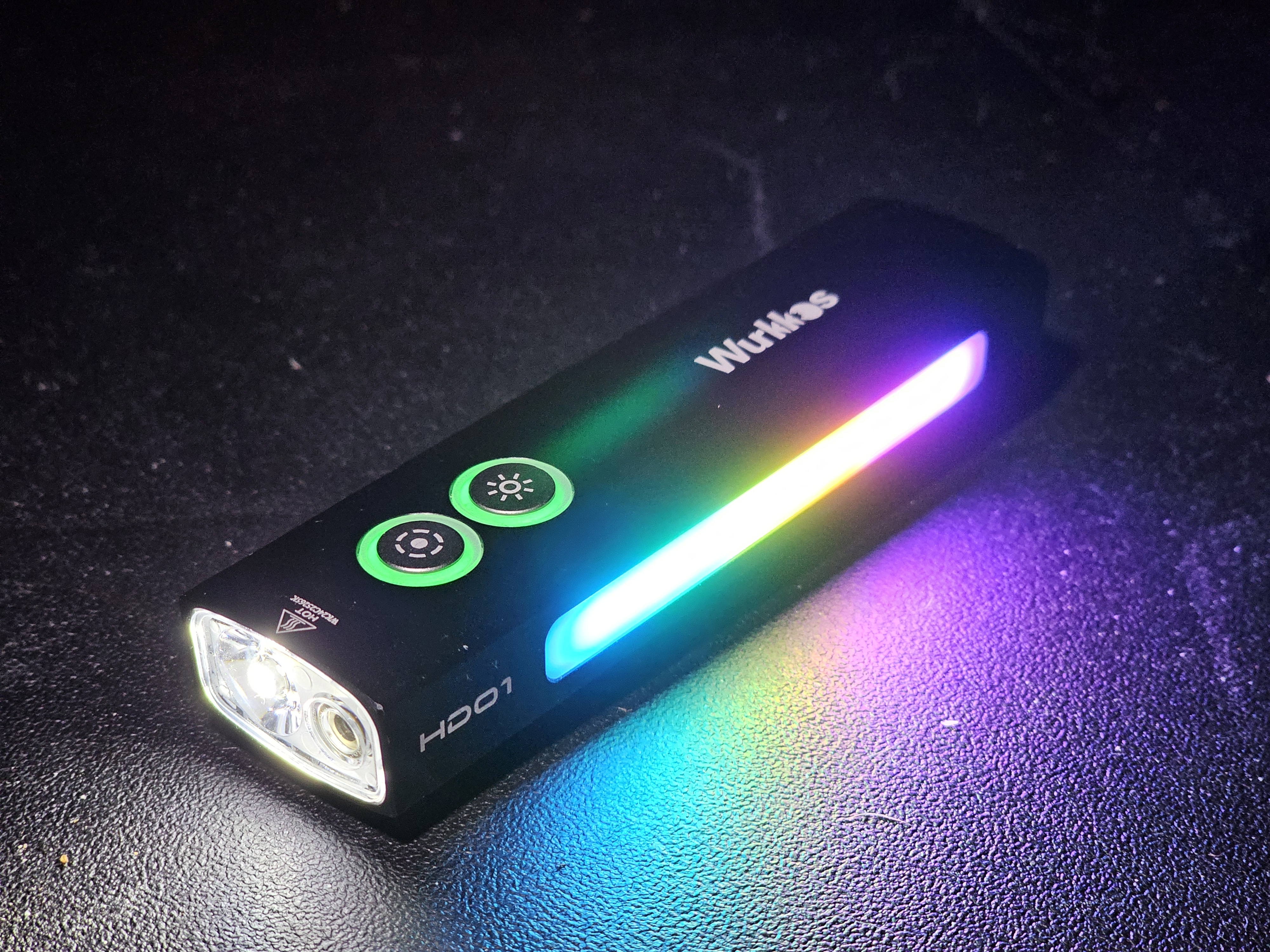 The Wurkkos HD01 is a small EDC light with a built in battery, white/RGB side LED, and a class 3R green laser.
The Wurkkos HD01 is a small EDC light with a built in battery, white/RGB side LED, and a class 3R green laser.
Introduction, Background, and Official Specs
Wurkkos hinted the HD01 earlier in 2024, and released it in April. The HD01 is aimed at the "small EDC" market category, and incorporates what appear to be the same side LEDs as the Sofirn IF24, but in a much smaller form factor and with the addition of a 5mW green laser. The small flat light form factor has seen interest recently due to the Olight Arkfeld, with TrustFire and Nitecore also releasing flat lights recently. These lights often have multiple different emitters in one light, and Wurkkos have opted for a green laser, and an option so far unique in small flat lights, a white+RGB flood LED strip (shared with the IF24).
Official specs and test results:
| Parameter | Official Value | Measured |
|---|---|---|
| Output (main LED, turbo) | 1,200 lm | 1093 lm |
| Runtime (main LED, turbo) | 1 hour | 1 hour 14 mins ANSI FL1; 1 hour 16 mins to 0 lm |
| Intensity (main LED, turbo) | 6,175 cd (157m FL1) | |
| Output (main LED, high) | 450 lm | 368 lm |
| Runtime (main LED, high) | 1.3 hours | 1 hour 18 mins |
| Intensity (main LED, high) | 2,348 cd (97m FL1) | 2,532 cd (108 m) |
| Output (main LED, medium) | 100 lm | 96 lm |
| Runtime (main LED, medium) | 4 hours | 5 hours 23 mins |
| Intensity (main LED, medium) | 656 cd | |
| Output (main LED, low) | 20 lm | 13 lm |
| Runtime (main LED, low) | 24 hours | |
| Intensity (main LED, low) | 94 cd | |
| Output (main LED, moon) | 1 lm | <1 lm |
| Runtime (main LED, moon) | 70 hours | |
| Intensity (main LED, moon) | 9 cd | |
| Output (side LED, high) | 180 lm | |
| Runtime (side LED, high) | 2 hours | 1 hour 19 mins |
| Intensity (side LED, high) | 98 cd | |
| Output (side LED, medium) | 25 lm | 31 lm |
| Runtime (side LED, medium) | 6.5 hours | |
| Intensity (side LED, medium) | 30 cd | |
| Output (side LED, low) | 1 lm | <1 lm |
| Runtime (side LED, low) | 70 hours | |
| Intensity (side LED, low) | 0.5 cd | |
| Output (laser) | 5mW | 2mW |
| Runtime (laser) | 13 hours | 16 hours |
| Runtime (RGB) | 8 hours | TODO |
| IP rating | IP65 | |
| Impact resistance | 1 m (3.28 ft) | |
| Weight | 95 g | 93.8 g |
General information:
| Parameter | Value |
|---|---|
| Battery | Built-in LiPo |
| Charging | Yes, USB-C with rubber flap |
| Emitters | LatticePower HM (6000-6500k), LatticePower CSP1313 (4500k), RGB, 520nm green laser |
| LVP | Yes |
| MSRP | $67 |
| Price (at time of publication) | $50 |
For runtime testing, I give two figures when possible. The ANSI FL1 runtime is calculated by when the light drops below 10% of initial output. I also attempt to run the light past this to find the point where it switches off automatically if possible. Many lights will run at 1 lumen of less for an extended time before powering off, and with these lights I note my observations on when the runtime test was terminated, and may terminate tests at this point as my current measuring setup has a minimum of 1 lumen. For testing of output, my acceptable margin of error is between 5% and 15%, with margin increasing with output.
I was sent this light for free by Wurkkos in exchange for a review. I am not receiving any commission for sales, and am giving my honest opinion without holding back on any negative experiences or overstating any positive. I may use affiliate links to Amazon or similar sites for things such as measuring equipment I use, but do not otherwise have any related interest in anything I mention.
First Impressions, Physical Design, and Build Quality
The Wurkkos HD01 uses a retail-style cardboard box with printed sleeve, with product photo on the front and specs on the back. The box contains relatively few accessories, with just a USB A-C cable and user manual.
The HD01 is a unibody design, with no obvious method of opening, as it uses a built-in lithium polymer battery. On the top edge is the Wurkkos logo and both switches, with a LED ring around each switch. and "HOT" and a serial number at the front by the emitters. On the left side when held facing away from the user is the side LED diffuser. Compared to the Sofirn IF24 which uses the same flood and RGB LEDs, the diffuser is narrower and more heavily frosted, rather than translucent, and the overall strip is about 20% longer than the Sofirn IF24's. "HD01" is printed on the side towards the front. The tailcap has the usual regulatory markings, and the opposite side is plain except for a USB-C charging port behind a rubber cover. On the bottom side, there is a pocket clip, attached using three hex screws, and underneath this, the surface is entirely rounded, so it relies on the clip to sit flat on a desk or table, although stability is good when doing this as the clip is wide, and the clip also incorporates a lanyard hole, although there was no lanyard in the box so if you want one, you will have to find your own. This is a reversible clip, although as it only runs halfway down the body of the HD01, it is possibly intended more for use as a hat light than for head-up carry, and people who use the clip will almost certainly want to carry head-down or half of the light will stick up from a pocket. The front of the HD01 is dedicated to the emitters, with a polycarbonate exposed TIR optic taking up most of the front face, other than a hole where the laser is located. The laser appears to be a separate optic placed within the TIR, and while in the course of testing and carrying the HD01, the TIR optic did pick up a few scratches, but the separate part over the laser did not, so hopefully this is glass rather than polycarbonate. While the exposed TIR is disappointing, it is of less concern with the main emitter which tends towards floody rather than having a lot of throw. I will go into more detail on this in Driver and Emitters.
The top surface of the HD01 is rounded towards the edges with a flat indented section in the middle that runs almost the entire the length of the light, including the switch area, which makes the HD01 easier to hold than if the entire top had been rounded, as it tends to catch your thumb and guide it towards the switches, with a gentle slope upwards to meet the rounded profile at each end. The USB port uses the typical rubber flap, and I would call the fitment average - while it never gave me worries that it would come open while being carried, and can be opened without feeling like it is at risk of breaking or being damaged, it also does not inspire confidence in its water resistance, with a relatively loose fitment, which is reflected in Wurkkos only giving the HD01 an IP65 rating, meaning it is rated as splashproof but not for immersion, overall a disappointing score for a light without a replaceable battery. The tailcap contains a medium-strength magnet, and the HD01 is able to support itself well on thick metal surfaces even when holding multiple sheets of paper, although on thin metal surfaces then its holding power is more limited and it can fall easily if bumped. The front of the HD01 is angled rather than straight - it is still able to headstand, but if you just casually place it down on its head without paying attention, it is likely to fall over, and it ends up standing at a slightly odd angle.
I did notice one quality issue with my HD01 - when shaken, the battery rattles inside it. I notified Terry from Wurkkos of this and he has stated that this issue was fixed for the second and subsequent production batches - at the time of writing, the first batch has entirely sold out so any new purchases are likely to be the revised version. Other than this, my HD01 was flawless, with a consistent smooth finish in the anodisation with no discolouration or inconsistent patches. The finish overall is matte, and held up well to normal carry and testing with no obvious marks or other damage.
Wurkkos's warranty is described on their website and is covered via the seller for the first 30 days, then after that, Wurkkos will repair the light within the warranty period (which seems to vary with different lights) if shipped to them.
Size Comparison
The HD01 covers several different categories of lights, so I used a combination of general EDC lights, work lights/mules, and RGB lights.
- Sofirn IF24
- Olight Arkfeld Pro
- Emisar D3AA
- Skilhunt Mix-7
- Fireflylite NOV-Mu v2
- Emisar D4K
- Emisar D4v2 Mule
- Wurkkos TS10
- Wuben X2
User Interface
Actions are given in Anduril-style notation. 1C means click once, 1H means click once and hold the switch. 2C means click twice in a row quickly, while 2H means click twice quickly, holding the second click.
As the HD01 has two switches, the forward switch controls the laser and side LEDs, while the rearward switch controls the main LED.
| State | Action | Effect |
|---|---|---|
| Laser off | 1C forward switch | Laser on |
| Side LEDs off | 1H forward switch | Side LED on (RGB) |
| Side LEDs off | 2C forward switch | Side LED on (white, mode memory) |
| Side LEDs off | 3C forward switch | Side LED on (special RGB modes) |
| Main LED off | 1C rearward switch | Main LED on (mode memory) |
| Main LED off | 1H rearward switch | Main LED on (moon) |
| Main LED off | 2C rearward switch | Main LED on (turbo) |
| Any | 3C rearward switch | Main LED on (strobe) + laser on* |
| Main LED on | 1C rearward switch | Main LED off |
| Main LED on | 1H rearward switch | Adjust brightness |
| Side LEDs on (any) | 1C forward switch | Side LEDs off |
| Side LEDs on (white/RGB) | 1H forward switch | Adjust brightness (white) or change RGB colour (RGB) |
| Side LEDs on (special RGB) | 2C forward switch | Cycle RGB mode |
| Laser on | 1C forward switch | Laser off |
| Any | 5C forward switch | Toggle swich LED breathing effect |
| All emitters off | 4C either switch | Lockout |
| Lockout | 4C either switch | Unlock to on* |
* Laser is always on when in strobe mode
** When using the forward switch to unlock, it unlocks to the laser being on, and the main LED if using the rearward switch.
I appreciate the ability to use the main LED and the laser at the same time, but this does end up with an odd combination in that the laser can be used in conjunction with the main emitter but not the side flood/RGB. However, the laser is still easy to control and quickly toggle off, so I still prefer this over the Olight Arkfeld Pro's much clumsier and slower implementation for the LED and laser at the same time, or the Sofirn IF24 where the main emitter can not be on at the same time as any others. Other than that one limitation, the laser can be combined and controlled separately without affecting the main emitter. Interestingly, there is one way to have all three emitters active, to activate the side LED first and then activate strobe, which activates the laser without switching the side LEDs off, although there is no way to change this to a useful state for all three, so this is possibly a UI bug.
The HD01's RGB modes are the same as the Sofirn IF24's, likely due to shared elements in the driver design, but the HD01's implementation here is worse than the IF24's - when ramping the RGB mix, the IF24's ramp is reversible by releasing and pressing the button, while the HD01's ramp direction is fixed, so if you miss the target you were aiming for, you have to go round again. In addition, several of the IF24's RGB modes are missing on the HD01. As with the IF24, there is no mode memory, and the police flash mode is first, which may be disruptive and annoying if trying to access one of the calmer modes such as RGB Waterfall.
| Mode | Description |
|---|---|
| Police flash | Red/blue alternating sides, multiple alternating fast/slow patterns |
| RGB waterfall | Automatically cycling RGB, chasing down the LED strip, from head to tailcap, all RGB LEDs in use |
| Droplets | Chasing RGB colours from head to tailcap, with only two colours visible at one time |
As mentioned above, there seems to be no way to access strobe mode without the laser. I am not sure why a strobe mode might need precise aiming ;) - this is a nice feature to have optionally, but I question the logic of always having the laser active - while actual use cases for strobe are relatively rare and often involve some kind of self-defence context (as I doubt the HD01 is going to be a light of choice for many light painters), the use of the laser here is a complicating factor - while. In general, I would have preferred it if the laser was only able to be activated from the forward switch, as the use of the laser could be seen as a more hostile/escalating action compared to just a strobe, although at 5mW rated power, this is an eye-safe laser, so not dangerous. That said, I am not sure exactly of the use case for a laser simultaneously with the strobe mode - strobe rarely needs to be precisely aimed to have the intended effect.
There is no battery check mode - when the HD01 is first switched on, the switch LEDs light up in either green or red to indicate a normal or low battery, but there is no way to tell exactly how much battery you have left. The other use for the switch LEDs is toggled with 5C to enable a "breathing" effect where the switch LEDs fade from off to full power, then back to off. This mode will always use the green LEDs even if the battery is low - it might have been a nice extra touch to use the red instead on a low battery as a visual reminder.
Overall, this is a reasonable user interface. I'm not a big fan of many dual-switch interfaces overall, preferring a more advanced single switch interface for controlling multiple channels, but this is one of the better ones, as it does react consistently with important functions such as lockout being available from both switches. Other than that, the interface is reasonably well designed with good responsiveness, shortcuts such as lockout being accessible in the way many users will have muscle memory for, and reacting to the user in the way that is typically expected.
| What it gets right | What it gets wrong |
|---|---|
| All the normal shortcuts do the right things - 2C turbo, 4C lockout, 1C switches off from turbo | RGB modes are significantly more limited than the Sofirn IF24 |
| Separate channels are mostly individually controllable | No battery check mode |
| The switch LED breathing mode is a nice touch | No brightness control on side LEDs or ramping on the main LED |
Using the Light
The HD01 is very small and light and disappears into all but the smallest pockets. Many people find a flat form factor less intrusive to carry than a cylindrical light as it can be easier to situate between different objects, and considering the HD01's relatively small size and weight, it is easily EDCable, either as a primary light or as a backup secondary light for someone who may carry it predominantly for the laser. The tailcap magnet is reasonably strong, although not the very strongest, and most metal surfaces allow the HD01 to attach stably and be easily repositioned without falling off. I am slightly disappointed I could not use the side LEDs with the laser, but the combination of the magnetic tailcap and laser allows for some interesting and fun applications such as creating a laser grid to crawl underneath.
The UI is clearly designed with concurrent use of the laser and main emitters, something the popular and competing Olight Arkfeld's UI has as a much clunkier operation to do compared to the seamlessness of the HD01 here, and I could see the HD01 being an excellent choice for people doing inspection or similar work who may need to both illuminate something and point out a specific area. The main LED is low CRI, so a high CRI option would likely be appreciated here, but overall the tint is reasonable and the beam contains relatively few artifacts. The laser does have some beam artifacts up close, but these disappear at a distance, and it is noticeably brighter than the Arkfeld, with reasonable visibility under normal lighting conditions, the dot only really being drowned out in strong sunlight.
Ergonomically, the HD01's finish is smooth and has a slightly slippery feel, but the pocket clip makes it easy to handle and it never slipped out of my hand entirely. Under normal use and testing it never developed any noticeable marks or scratches, although the TIR optic did pick up a couple of minor scratches from carrying. The HD01 fits well into my hand, although some users with very large hands may find it slightly short necessitating an adjustment of grip to operate the buttons.
The side LEDs are high CRI, and not quite as bright perceptually to me as on the IF24, but also appear to have a slightly nicer tint, possibly helped by the more heavily frosted diffuser. Similarly, the RGB modes are also slightly less bright, again likely due to the optic. Main emitter output is very good considering the small size of the light. Compared to the obvious competitor, the Olight Arkfeld Pro, the output appears slightly lower, but with a tighter and throwier beam and marginally nicer tint.
When run on turbo, the HD01 heated relatively rapidly to around 35-40 degrees, before starting to gradually level off in heating rate, reaching a maximum temperature of 51 degrees after 5 minutes.
As mentioned in User Interface and similarly to the IF24, there is no brightness control on the RGB modes, with just one fixed output level that is a little too bright to be comfortable up close, and usable for illumination of an immediate area or ambient mood lighting in a room, but not usable as a general purpose flood channel, and in addition, the red mode is too bright to be reasonably usable for preserving night vision up close, although works a bit better for this purpose at a medium distance. The white mode does work for general purpose indoor room lighting, with a very wide beam angle close to 180 degrees, possibly slightly less wide than the IF24's due to the smaller diffuser, but still wider than most other ultra-floody lights such as Emisar or Fireflylite mules.
The side LEDs' CCT is not specified, but these appear to be the same LatticePower LEDs that Sofirn used in the IF24, with a CCT of approximately 4500k and a CRI of 91. DUV is relatively neutral.
Driver and Emitters
Not much detail has been released on the HD01's driver, although given the small size and output drop with battery depletion, I would expect it is likely a linear regulator. The output from the main emitter is overall very good given the HD01's small physical size and battery capacity, and while I was not expecting completely flat regulation, the drop in output is reasonably small as the battery depletes until near the very end of the test runs. The laser seems to have very good regulation, and did not drop in power through the test run at all until it entered LVP and switched off. Most green laser diodes have a forward voltage of 4V or more, so with the consistent output and regulation point to a boost driver here.
The main emitter is a LatticePower HM, listed as 6000-6500k. This emitter and optic combination has a moderately throwy beam profile, with smooth spill with relatively few distinct artifacts other than two lines visible up close, and reasonably good tint consistency with only a slight band of yellow around the hotspot. CCT ranged from 6361k on moon to 7186k on turbo, with a relatively strongly negative DUV at all points - while I may be known for liking cool CCTs more than some people, I feel that most people will at least find the HD01's tint acceptable for a cool white LED.
For the side flood LEDs, the HD01 uses the same LEDs as the IF24, LatticePower CSP1313, but the ones in the HD01 read as closer to 4500k than the 5000k seen on the IF24 - this likely explains the lower output when compared to the IF24 if a lower CCT bin was used. I was able to confirm that the 90 CRI bin is again being used, and my sample measured at 91. The DUV is slightly positive - less positive than on the IF24, likely helped by the more heavily frosted diffuser, and the beam profile is almost as wide at close to 180 degrees, although very slightly less, likely due to the narrower diffuser. Overall, the flood LEDs are usable for up close tasks without much problem, and at the low output levels and with the CCT on the warm side of neutral, overall I feel some good tradeoffs were made here.
I measured the HD01's CCT and CRI with a Colormunki Photo and ArgyllCMS.
CRI and tint
Power and Charging
With a fixed nonreplaceable LiPo battery, built in charging is the only way to use the HD01. The charging port is protected by a rubber flap, which feels slightly loosely fit, and likely contributes to the poor IP rating.
The switch LEDs turns red when charging and green when the charge is completed. Charging works with both USB-A to C and C-C cables.
Charging data was collected using rd-usb with an RDTech TC66C (info, Amazon (US).
Moddability and Repairability
Two words: "Good luck!"
The only obvious point of entry into the HD01 is the tailcap, where a pry tool might be usable to gain access. The internal battery is presumably closest to the tailcap based on the rattle mine has when shaken, but access to the rest of the light such as the driver or emitters is likely to be difficult or impossible. If anyone has any teardown photos, I would be interested to hear about it so I can feature or link them.
Performance
All lumen measurements taken using a 4.5 inch Texas Ace lumen tube. Candela measurements were performed indoors at a distance of 3m, using a UNI-T UT383BT datalogging luxmeter.
Runtime tests were performed using the lumen tube's HS1010A luxmeter, which the tube is calibrated for, with data recorded via taking a video, exporting the individual frames using ffmpeg, and parsing the value on the luxmeter's display at the appropriate frame for each measurement. I logged the value every second for the first 5 minutes, then every 5 seconds up to 30 minutes, then every 30 seconds past that point.
Output and Throw
| Mode | Spec | Peak output | Output after 30s | Output after 1 minute | Output after 90s | Output after 5 minutes | Output after 15 minutes |
|---|---|---|---|---|---|---|---|
| Turbo, main LED | 1200 lm | 1093 lm | 1014 lm | 988 lm | 685 lm | 445 lm | 302 lm |
| High, main LED | 450 lm | 368 lm | 364 lm | 362 lm | 360 lm | 351 lm | 94 lm |
| Medium, main LED | 100 lm | 96 lm | 96 lm | 95 lm | 95 lm | 94 lm | 92 lm |
| Low, main LED | 20 lm | 13 lm | 13 lm | 13 lm | 13 lm | 13 lm | 13 lm |
| Moon, main LED | 1 lm | <1 lm | <1 lm | <1 lm | <1 lm | <1 lm | <1 lm |
| High, side LED | 180 lm | 224 lm | 203 lm | 179 lm | 129 lm | 125 lm | 115 lm |
| Mode | Spec | Peak candela | Candela after 30s | Candela after 1 minute | Candela after 5 minutes |
|---|---|---|---|---|---|
| Turbo, main LED | 6,175 cd (157m) | 8,296 cd (182 m, 134% of spec) | 7,816 cd (177 m) | 5,096 cd (143 m) | 3,488 cd (118 m) |
| High, main LED | 2,348 cd (97m) | 2,532 cd (108 m, 107% of spec) | 2,396 cd (98 m) | 2,380 cd (97 m) | 2,312 cd (96 m) |
Runtime
| Mode | Spec | Runtime |
|---|---|---|
| Turbo, main LED | 1 hour | 1 hour 14 mins ANSI FL1; 1 hour 16 mins to 0 lm |
| High, main LED | 1.3 hours | 1 hour 18 mins (both) |
| Medium, main LED | 4 hours | 5 hours 23 mins (both) |
| High, side LED | 2 hours | 1 hour 19 mins (both) |
| Laser | 13 hours | 16 hours to power off |
| RGB | 8 hours | TODO |
Laser Performance
I measured the laser's performance with a Sanwu Tracer - this meter is designed for significantly higher power levels than the HD01's spec of 5mW, and I did run into some difficulty in taking these measurements, as at this low power range, the reading is noticeably affected by changes in ambient temperature and even airflow near the test area. As such, I limited the test to a short runtime to collect accurate power figures, then did a separate test for overall runtime. I measured 2mW from the laser on the short run, while on the long run, the measured power figures were not accurate so I only took overall runtime - the HD01 was able to run the laser for a total of 16 hours continuously and when it entered LVP and the laser switched off, when switched back on it still read 2mW, showing excellent regulation on this channel.
Performance Overview
The main emitter does not use a particularly efficient driver, with output steadily dropping with battery level. I could not find a spec for the battery capacity anywhere so direct comparisons are difficult, but I would guess the driver uses a linear regulator. The laser, on the other hand, sustains its performance all the way from full to empty, with relatively little fluctuation in measured power at a steady 2mW, noticeably exceeding its runtime spec by 3 hours. ~1100lm is decent for a small light, with a balanced beam with perhaps a slight bias towards throw. Efficiency on the side LEDs is noticeably lower than the main LED, with a runtime of only 1 hour 19 mins on high. Throw was slightly better than advertised, and better than many other small flat lights such as the Arkfeld, and not that far off the Wuben X2.
Beamshots
| Light | Emitters | Notes |
|---|---|---|
| Olight Arkfeld Pro | Osram P9, 5700-6500k | Tested at 1350 lm |
| Sofirn IF24 | SST40 6500k | Tested at 1616 lm |
| Emisar DW4 | 519A 5000k | Boost driver, tested at 2300 lm |
| Wuben X2 | Osram P9, 6000k | Tested at 2300 lm |
| Convoy T3 | 519A 5700k | Tested at 430 lm |
| Emisar D4v2 mule | 8x 519A 5700k | Tested at 4500 lm |
| Skilhunt Mix-7 | XP-G4 6500k | Main LEDs tested at 2380 lm |
| Emisar D3AA | 519A 5700k | Tested at 1800 lm |
HD01
Comparison Beamshots
HD01 Laser Beamshots
Competitors
Olight Arkfeld Pro: The natural competitor to the HD01 most people might think of (along with the older non-Pro Arkfeld, which lacks the UV mode). Very similar squarish form factor (the Arkfeld is slightly longer and heavier), single LED plus green laser. The Arkfeld Pro lacks the HD01's side LEDs, but instead has a UV emitter, although the UV itself is made less useful by the absence of a ZWB filter. The Arkfeld's laser is noticeably less powerful than the HD01's, but the main emitter is slightly brighter and floodier. Both have built in nonreplaceable batteries, although the Arkfeld uses Olight's proprietary magnetic charger instead of USB. In my opinion, the HD01 has an overall better UI, and in particular is much nicer to use the laser and main emitter together, but the Arkfeld's is simpler to use and learn. The choice between the HD01 or Arkfeld is likely to come down to if you would prefer UV or high CRI flood/RGB LEDs, as well as how much laser performance you need.
Sofirn IF24: Significantly larger, replaceable battery, similar side LEDs with more modes and marginally higher brightness. Brighter main emitter but less nice beam. User interface is overall somewhat less usable, but has a better interface for the RGB modes.
Skilhunt Mix-7: The Mix-7 is an alternative choice for a light with both RGB and white emitters, as well as a magnet. The Mix-7 has a larger diameter than the HD01 but is overall smaller. While the Mix-7 usually would be considered weak in capacity and runtime with its 18350, it still compares positively to the HD01's built in battery. Significantly more powerful main emitters, combined with RGB that is less floody and more of a balanced beam, although despite the name, there is no way to actually mix the RGB; you get red, green, or blue, so it depends strongly on what you want the RGB mode for.
Wuben X1/X2, Nitecore EDC27: If the flat form factor is the main thing you are looking for, but the HD01 or Arkfeld are too small and low powered, these are some of best flat lights around for overall performance. Significantly larger, main LEDs only, but with much higher overall main LED performance.
This section does not list all possible alternatives, is subject to my own interest and views on listed lights, and is primarily intended to give a general overview. A light not being included here does not mean it should not be considered a viable alternative.
Potential Improvements
Trying out a new section here: How I would improve the design of a light. No, I'm not going to say "Anduril and an extra 10,000 lumens" every time, even if that would improve every light ;) - these are intended to be small design changes that could be made while keeping the overall focus of a light.
- 14500 battery: Many enthusiasts dislike built-in batteries, and for good reason. All rechargeable lithium batteries eventually wear out. It leaves the user reliant on either the manufacturer, or the community to provide support when that happens. Some people will argue that even with heavy use, you can get 2-3 years from a battery, but ultimately, I object to this on planned obsolescence and environmental responsibility grounds. The HD01 is large enough that two 14500 cells should be able to fit inside (and even if it needed to grow a little, it is smaller than its main competitor as it is), and USB charging is already integrated, so the cells could be *semi-*replaceable if needed, similarly to the Wuben X1 - doable, but not something you'd want to do every day.
- Better RGB modes: The IF24 has additional RGB modes that are not present on the HD01. These could be added, in addition to reversible RGB ramping.
- Optics - the laser has a few beam artifacts that could be improved, while the main emitter has a bare TIR that will pick up scratches much more easily than a glass lens.
- LED: The LatticePower HM was presumably chosen for output. In general, for a small light, this is probably a good choice, but enthusiasts would still be happy to trade some output for a high CRI version with 519A, or possibly even a throwy version with a slightly lower CCT with an Osram W2 (CSLPM1.TG) while still retaining comparable output.
Final Thoughts and Score
| Category | Score | Comments |
|---|---|---|
| Looks | 8/10 | While it may not be the first light to use the same basic shape, the HD01 does put a lot together into a very good looking package. The fit and finish are both excellent, the buttons integrate well into the top surface, the pocket clip is unobtrusive when beneath the light, but still usable, and the side USB port disappears relatively well when not in use with the cover inserted, with only a very small visible disturbance to the overall lines. |
| Quality | 6/10 | The exposed TIR optic is a disappointment, and will pick up scratches with use, but this seems to be the case in all other similar flat lights. As noted earlier, my review sample has the battery rattle issue, but this has been resolved for the batch available at the time of publication. The laser is prone to beam artifacts, particularly if the lens is slightly dirty, but this does not affect the actual performance to any extent that I could determine. The USB-C port's rubber flap cover does not have the tightest fit (this is likely the cause of the poor IP rating of IP65 - in my opinion, there is very little justification for a light with a built-in nonreplaceable battery to not have an IP rating suitable for at least brief immersion). Other than these issues the overall fit and finish seems excellent - nothing seems loose, the side LED strip is slightly inset from the body but feels well attached. Overall, the built-in battery is the biggest problem I have with the HD01's design, particularly when the body size seems appropriate for a 14500 cell instead, so the battery situation is notable as a specific detraction from the quality score. |
| User Interface | 7/10 | The user interface is on the simple side, but still more configurable than those in other similar lights. I appreciate the ability to use either the side LEDs or laser at the same time as the main LED, although the lack of a way to use the side LEDs and laser is a disappointment to anyone trying to make their own dark room laser maze challenge. Lockout shortcuts will be familiar for most users' muscle memory, and there are no gaps in the click patterns - every sequence up to 5C does something, although it can be a bit hard to remember that the side RGB function is on 1H as a result, as this is the only hold-based shortcut from off. Past that, there are no unwelcome surprises, the generally-accepted preferences for things like moonlight and turbo are implemented. The breathing switch LED mode is a very nice addon and really gives the HD01 a premium feel, although I also feel like there is a slight missed opportunity to use them as a battery indicator as well, either by mixing the green or red LEDs, or switching to red when the battery is low. The RGB UI is a weak point of the HD01 when compared to the Sofirn IF24, with several RGB modes missing, and no way to reverse the direction when adjusting the colour mix, so if you miss the intended mix, you have to ramp all the way back around. The UI does take some exploration to learn without reference to the user manual, so I would suggest reading it at least once. |
| Performance (absolute) | 7/10 | The main emitter produces 1093 lm, an acceptable figure for a small light with a built in battery, but not spectacular. The side LEDs are similar to the IF24's - the RGB is mostly useful for up close, while the white can serve as room lighting at a low level. The HD01's laser was able to consistently output 2mW at all battery levels from full to immediately before LVP, and while noticeably below spec, still outperforms the Arkfeld Pro, which I measured using the same setup at around 1mW, with larger fluctuations in output. Note that these measurements should not be considered 100% accurate as my laser power meter was designed for lasers in the 100mW to multi-watt range, and at 1-2mW, things like ambient temperature and airflow have a noticeable effect on the reading. I also feel that pushing the output closer to 5mW would be a bad idea just in terms of having a potentially-dangerous laser in the hands of people who may not have a good understanding of laser safety. |
| Performance (sustained) | 7/10 | The HD01's turbo mode is noticeably thermally limited, dropping to a level below the high mode after 7 minutes, and overall runtime for turbo and high is very comparable. The main and side LEDs do not seem to be using an efficient and well-regulated driver, with output dropping steadily with battery level, and overall runtimes falling short of the Arkfeld. Wurkkos do not provide any battery specs, so I am not sure exactly how much of this is due to a smaller battery and how much is due to a less efficient driver. The laser performed significantly above spec in runtime, running for 16 hours vs a spec of 13 hours, and power level remained consistent through the run. |
| Moddability and Repairability | 3/10 | The tailcap seems to be the entry point to get into the HD01, but this is extremely unlikely to be an easy job, and there appears to be no way to access the LED without a full disassembly. |
| Practicality | 8/10 | Options for a light/laser are few and far between, and the HD01 is unique in offering flood and throw(-ish) LEDs, which may or may not be more useful than the Arkfeld's UV, depending on use case. The magnetic tailcap allows for secure attachment even to relatively thin metal, and while the flood LEDs lack the power for wide area lighting, they are perfectly usable for indoor or ambient lighting, or up-close task lighting. The form factor lends itself extremely well to pocket carry, and the clip is clearly designed with use as a hat light(/laser) in mind. The main limitations here are the relatively quick and deep stepdown from turbo, and the small battery size, although if the HD01 is primarily intended to be used for its laser with the LEDs as a backup for general purpose lighting, practicality is excellent with runtimes noticeably exceeding specs. |
| Value | 8/10 | In general, I am hesitant to buy lights with built-in batteries due to concerns about batteries ageing and being unable to be replaced, but with an MSRP of $67 and, at the time of writing, a sale price of $50, the HD01 potentially falls into the area where the battery might be acceptable. Certainly, I would be a lot less hesitant to spend $50 on an HD01 than $100 on an Arkfeld Pro when considering the battery situation. 1 point is still lost here directly due to the built-in battery; I would have rather seen compatibility with a standard li-ion cell here even if it ended up raising the price. |
| Fun | 9/10 | With the laser, RGB, and breathing switch effect, the HD01 is not lacking in features, and the user interface ties all these together reasonably well. While my usual fun of hitting turbo is less impressive on the HD01 than some lights, it is still good for the size, and will certainly impress any nonenthusiasts. |
| Overall | 8/10 | The HD01 brings a lot of functionality into a very small package, and while I would perhaps rather have seen a more traditional package for things like replaceable batteries and better thermal management, the HD01 nails everything that it would be expected to do, in a small and well-designed light. While it's not going to become my EDC any time, it is probably a solid choice for most people, especially those who need the use of a laser as well. Compared to the Arkfeld Pro, I prefer the HD01 in functionality, user interface, and general design, with it only falling slightly short on performance of the main emitter. If you need a light/laser but primarily for the laser, the HD01 is an excellent choice, significantly outperforming the Arkfeld's laser for a lower price. |
The HD01 is available from wurkkos.com, and Wurkkos' official AE store. Atthe time of writing, it is currently available for $50 on Wurkkos.com, with an aditional 20% off for buying two or more using the discount code SPRING20.
As always, feedback is welcome - I am active on BLF or Reddit, both on /r/flashlight and other specific subreddits, and have started my own subreddit for review content at /r/WolfgirlReviews.
>> Home























